
- CV Examples
- CV Templates
- Cover Letter
- Job Interview
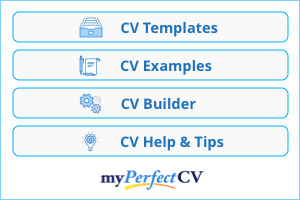

Email Cover Letter and CV | Sending Tips and Examples

What is an email cover letter?
An email cover letter is essentially a job application email through which you apply for a job. The email must contain your cover letter, either in the body of the email or as an attachment, and your CV as a separate attachment.
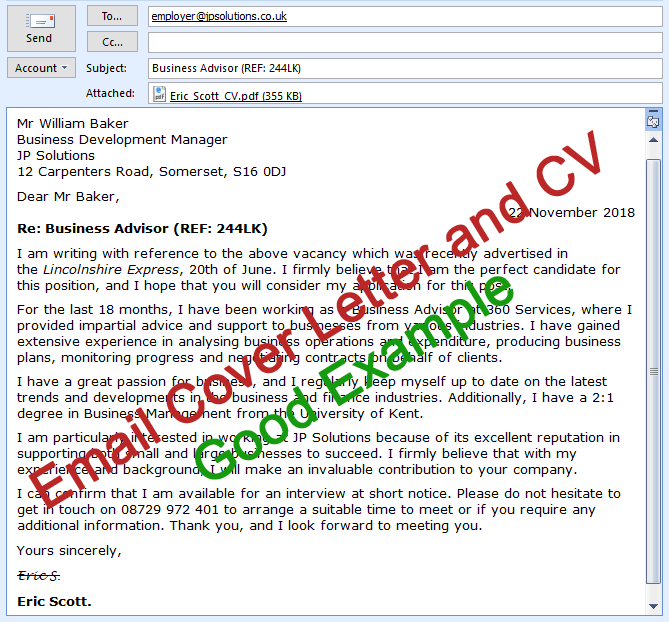
Do you need to send your CV and cover letter via Email?
With the massive technological boom over the past decade, we have seen the dramatic rise in email applications. Sending an email is free, it doesn’t require a stamp, visit the post office or a trip to the company you’re applying for. It all happens within seconds and with just one click of a button.
There are two main reasons why you would send an email to a recruiter:
- When you’re applying for a job
- When you’re enquiring about job opportunities at their company
In this guide, we will mainly focus on applying for jobs that have already been advertised . However, read on as there are also tons of tips and examples for those who wish to inquire about job opportunities via email.
The format of an email cover letter + template
The format of an email cover letter slightly varies from the format of a standard cover letter. For example, there is no need to include your personal details such as name and address on the right side of the letter because your attached CV will already contain all this information. Moreover, it will take up valuable space.
Your email to the recruiter should be in the following format:
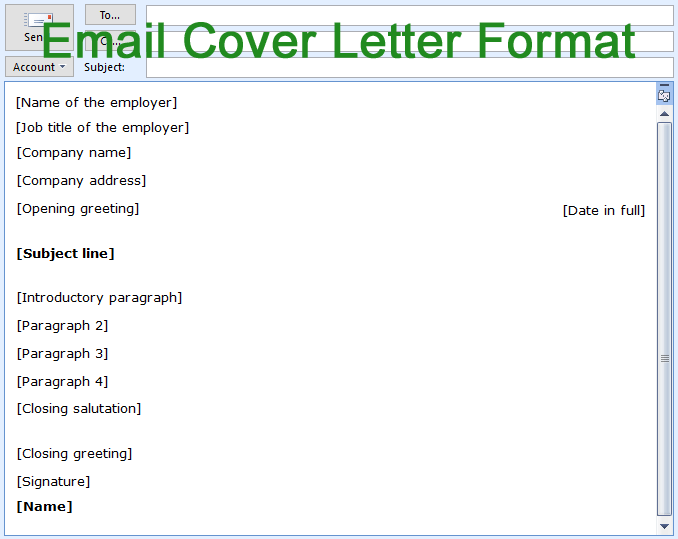
Click here to download this template.
Before you start…
1. Have your perfect CV and cover letter ready
Before working on drafting your email, make sure that you have already written and prepared your CV and cover letter. Check out How to write a Cover Letter and How to write a CV guides for more tips and examples.
2. Be formal
The job application process is a formal process. As such, you have to have a formal approach to writing your email job application.
- Don’t use contractions (e.g. I’m instead of ‘ I am ‘ or Let’s instead of ‘ Let us ‘)
- Write in complete sentences
- Write in paragraphs (not in short lines, as you would in text messaging)
- Use formal greeting (use ‘ Dear Sir/Madam ‘, ‘ Dear [Surname], ‘ or ‘ To whom it may concern ‘ rather than ‘ Hey ‘, ‘ Hi ‘, or ‘ What’s up? ‘)
- Don’t write in capitals (IT’S NOT NICE TO READ TEXT IN CAPITALS!)
You can find more information on formal writing here .
3. Use a professional email address
You must use a professional email address when contacting the recruiter.
It should be:
- It should be short in length
- It should contain your name
- It shouldn’t contain any/many numbers
Acceptable examples:
- [email protected]
Unacceptable examples:
4. Keep it short and to the point
You only have one chance to grab the attention of the prospective employer, so keep the letter short and to the point. Employers only tend to scan CVs and cover letters for less than a minute. Anything longer than a single side of A4 will most likely not be read or considered. Why take the chance? You will have plenty more opportunities in the later stages of the recruitment process, including during the job interview, to fully impress the prospective employer.
5. Write the content of the email in a separate document first
It is highly recommended to write your letter in a separate Word document first rather than typing it up on the actual email client in one go. This is because there will be a smaller chance of losing your work because of the loss of internet connection or the software crashing in the middle of writing your letter.
It also gives you additional time to properly check your written document for grammar and spelling mistakes.
How to send a cover letter and CV via email
Let’s get started…
1. Email subject line for job application
The subject of your email should be the job position followed by the job ID or job reference number:
- IT Manager (ID: W124)
- Receptionist (Job Ref. A2014)
- Cleaner (Job ID: AFT2421)
That’s all that is required.
If you decide to add anything extra, e.g. including your name or a short message, please keep it short as there is a limit on how much of the subject line will be shown to the recruiter when they receive it in their inbox.
Do not write your subject line in capital letters
Some applicants, in a desperate attempt to make their email stand out from the rest, write the subject line of their emails in capital letters, like this:
This is not recommended for two reasons:
- It is awful to read, and;
- You come over as either too desperate or too aggressive. In the worst case scenario, you come over as both.
QUESTION: Should you write the cover letter in the body of the email or send it as an attachment?
Some employers prefer attachments, whereas others prefer the letter in the body of the email. Please check for company requirements on the job advertisement. If the company has not specified their preference, it is up to you how you’d like to send your cover letter to them.
It’s decision time!
As previously stated, there are two acceptable ways of doing this:
1. Include the cover letter as an attached file
If you decide to attach your cover letter separately to the email, always write a short message in the body of the email introducing yourself and giving the reason for emailing the recruiter – don’t leave it blank! The content of your email body should be short, informative and to the point:
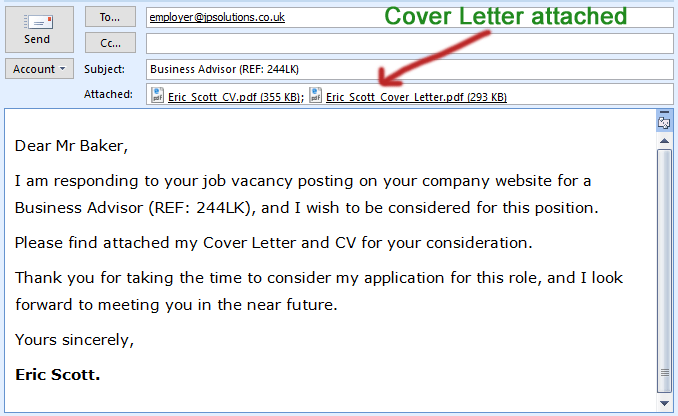
Another good example:
Please find attached my CV and Cover Letter for the position of Senior Research Fellow.
I look forward to hearing from you!
Kind regards, Michael Harper.
2. Write the cover letter in the body of the email
This is the most popular way of sending an email job application.
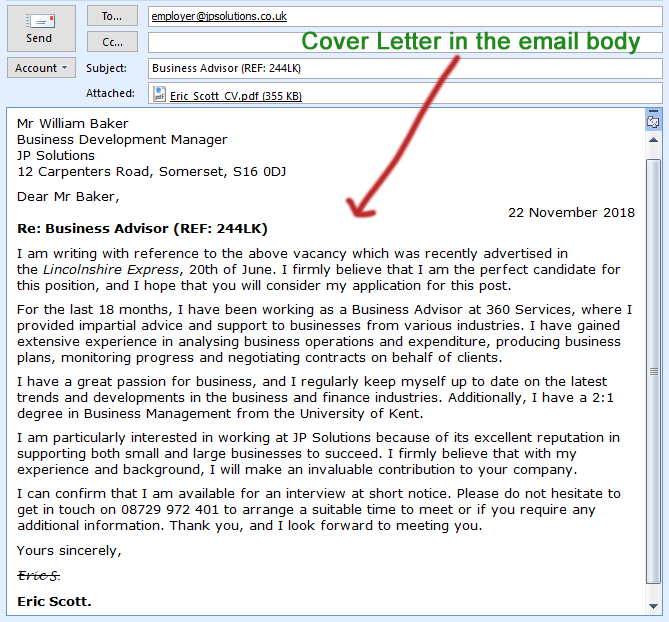
I can already hear you ask “which one is better?” glad you asked.
Our recommendation is to write the cover letter in the body of the email. It gives the opportunity to make a strong and memorable first impression, allowing you to grab the prospective employer’s attention within seconds.
If you send it as an attachment, on the other hand, the employer has to take the additional step of finding and opening your letter in order to read it. Some recruiters will not open attachments out of fear of infecting their computers by viruses.
Warning: Don’t include the same cover letter in the body of the email and as a file attachment. That is just a weird thing to do and makes you look very indecisive.
The remainder of the guide will show you step-by-step how to write your email covering letter in the body of the email:
How to start an email
2. employer’s personal details.
The first few lines of your letter should be the personal details of the recruiter:
- Recruiter’s full name
- Recruiter’s job title
- Company name
- Company address
Good example:

3. Opening salutation/greeting
The next line of your covering letter is the opening salutation, which should be written in the following format:
“Dear” followed by their honorific title (Mr, Mrs, etc.) and surname.
- Always use formal greeting (e.g. ‘ Dear Sir/Madam ‘, ‘ Dear [Surname] ‘ or ‘ To whom it may concern ‘ rather than ‘ Hey ‘, ‘ Hi ‘, or ‘ What’s up? ‘)
- It’s always best to find out the name of the employer to whom you are written the letter. This makes the letter more personal and convincing.
- If you’re addressing the employer by name, only include their surname (Dear Mr Kent) and not their full name (Dear Mr Simon Kent).

The next line should include today’s date in full ( 10 November, 2018 instead of 10/11/18 ), aligned to the right.
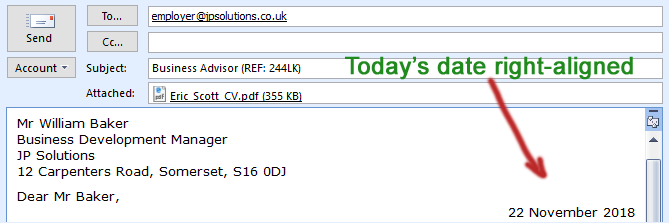
5. Introductory paragraph
State the reason why you are writing this covering letter.
For example:
I am writing to express my interest in the Electrical Engineer role listed in The Worcester News, 19th of March 2017. After carefully reviewing the job requirements, I feel I have all the necessary experience and technical skills to excel in this position, and I would wholly appreciate your consideration.
- These are the first few sentences that the prospective employer will be reading about you; make sure the introductory paragraph is short , to the point and is written for high impact .
6. Paragraph 2
In this paragraph, clearly outline the reasons why you would be a suitable candidate for this position. Make mention of your relevant education, qualifications, work experience, strengths, skills and abilities.
I graduated in 2014 with a first-class degree in Librarianship from the University of Essex, and I worked for a year as a Junior Librarian at Summerfield College. Both my education and work experience have given me a great insight into the purpose, function and processes of libraries. I am trained in all the standard library information and data management systems.
- Try to back up your statements with real-world examples. For instance, if you wrote that you have an “ excellent track record in sales “; back it up by tangible and verifiable performance information, e.g. by stating that you “ increased the company’s sales by 23% in six months. “
7. Paragraph 3
Following on from paragraph 2, expand on more reasons why you would be the ideal candidate for this job position.
I graduated in 2015 with a 2:1 degree in Business Management from the Queen’s University Belfast, something which kindled my passion for business and the economy. I studied a broad variety of topics ranging from Marketing Principles and Corporate Responsibilities to Leading Change and Strategic Management. I am a driven, ambitious and analytical individual with the excellent ability to analyse current business operations and offer meaningful solutions based on the findings.
8. Paragraph 4
This is going to be the final information-packed paragraph of your cover letter. Mention any other selling points that you have and state the reason why you are interested in working for this particular company.
I am especially attracted to joining your organisation because of the emphasis it puts on long-term growth and training within the company. Challenges motivate me, and I believe that I would be able to bring together my prior knowledge and skills as a competent Recruitment Officer. I am confident that my records of impressive accomplishments over the past few years prove that I will become a valuable asset to Lancefield Recruitment.
- Do research about the company you are applying for and use your findings to draft this paragraph. This will make you look interested, intelligent and resourceful in the eyes of the prospective employer.
How to end the email
9. closing statement.
The final paragraph is usually a polite call for action in which you state that you are looking forward to meeting the prospective employer. It must also contain a reference to your CV that you have attached with the application.
Useful phrases you can use:
- Please find attached my CV for your consideration.
- I have attached my CV with this email.
- For your consideration, my CV is attached with this email.

10. Closing salutation
The closing greeting should be “Yours sincerely” only if you addressed the employer by name (e.g. Dear Mrs Sanders) at the beginning of the letter.
If you used “Dear Sir/Madam” or “To whom it may concern” as the opening greeting of your letter, it should end with “Yours faithfully.”
Other alternatives that you may use instead of “Yours faithfully”:
- Best regards
- Kind regards
- Best Wishes
11. Signature & Sender’s name
Sign off the letter with a signature followed by your name.
If you do not have a scanned or electronic signature, you can write the signature in the following format:
- Email address
- Telephone number
- LinkedIn profile – optional

That is it – you should now have a perfectly written email cover letter!
- Don’t rush by writing and sending your email in one go – you will most likely forget to include important things or make many factual, grammatical or spelling mistakes. Write a draft version first, take a break, and then come back again in a few hours time to review it.
- Don’t forget to attach your files ! You only have one chance to make a good impression, make sure you don’t mess it up with clumsy mistakes.
- Send a test email to yourself first to double-check the email’s format and whether attachments can be opened.
- Give the attachments identifiable file names, for example, “ Julia_McCaree_CV.pdf ” is better than “ newhkh34.pdf “
Shall I send my documents in Word (.doc or .docx) or PDF format? Both methods are acceptable. However, we recommend you send it as a PDF file because that will preserve the format and presentation of your documents; including margins, padding, spacing and indentation.
How do I find out if my job application email has been received? Unfortunately, you can’t be sure whether the employer has opened or read your email unless they tell you so. Some email clients allow you to ask for a “Read” receipt after the sender has opened your email. However, you will only receive a “Read” receipt if the recipient decides to send you one.
After how many days shall I follow-up my application? Most job vacancies will state the timeframe in which you should hear back from them if you have been shortlisted for an interview. Many job vacancies will state: “If you do not hear back from us within 2 weeks time, please assume that your application has been unsuccessful this time.” If, however, this is not specified you should get in touch with them after a week to follow-up on your initial application.
Should I use the “ high importance ” flag when sending my application? No, not really. The high importance flag has lost its value years ago. Besides, there is a chance that you will come across as rude as why should your job application email be more important or urgent than those of other senders? More than 90% of emails are sent without one.
Working on your CV? Awesome!
- IT CV Example [2024 Guide + Tips]
- Professional memberships on a CV (2024 Guide)
- Laundry Assistant CV Example [2024 Guide + Tips]
- Social worker CV Example [2024 Guide & Tips]
Over 15,000 amazing people have connected with us - and you're amazing too!
Copyright © 2024 CV Plaza All Rights Reserved
Privacy Overview
What to write in an email when sending a CV
When sending your CV to employers or recruiters via email, it’s important to write an effective message
But what should you write to catch their attention and persuade them to open your CV?
This guide will explain everything you need to write, and even has some example emails to copy.
CV templates
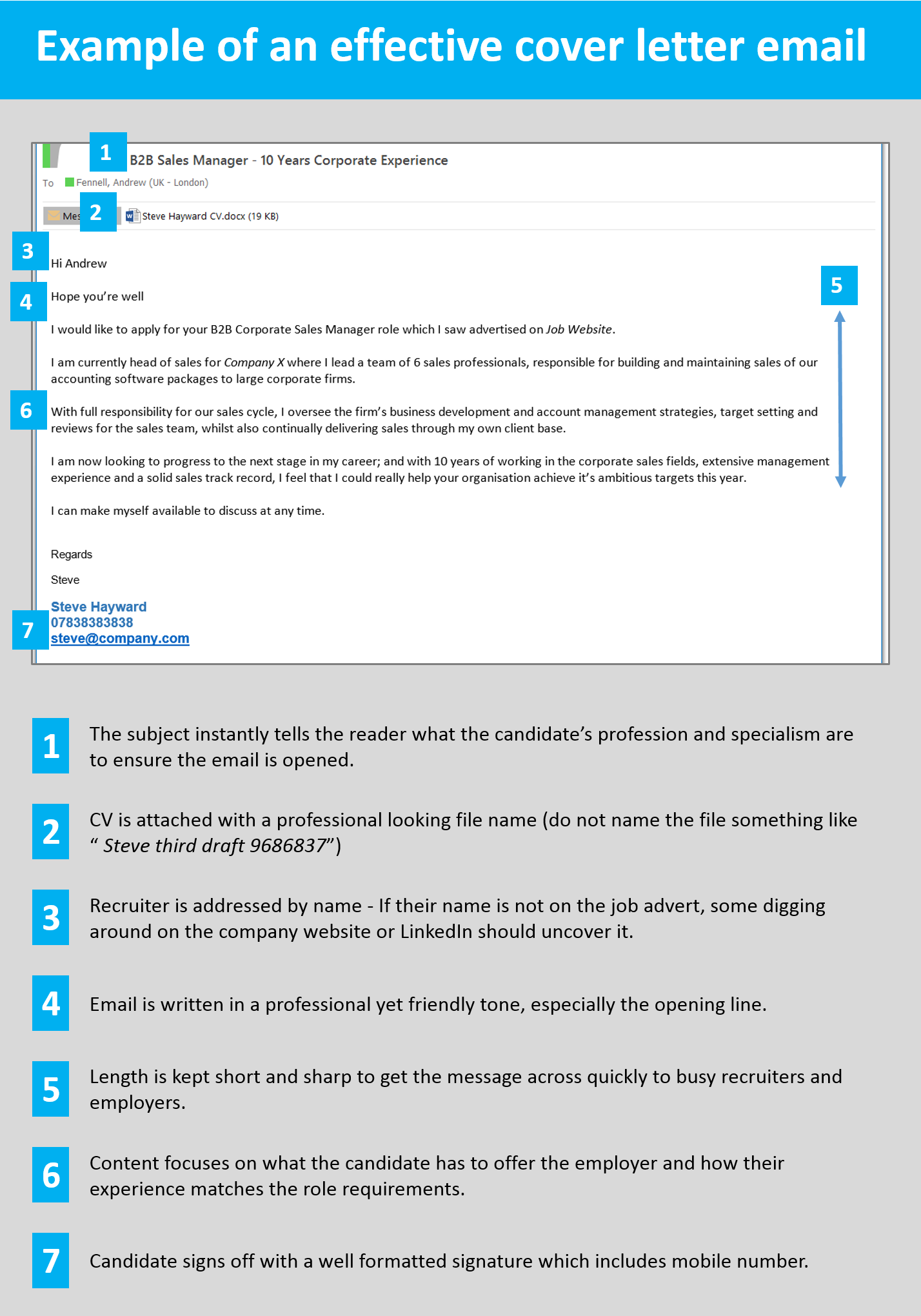
Subject line
When sending an email applying for a job, keep in mind that your first goal is for the recruiter to open your message – this means capturing their attention and giving them a reason to click on your email.
So rather than writing the same subject as everyone else, use this chance to start selling yourself right away.
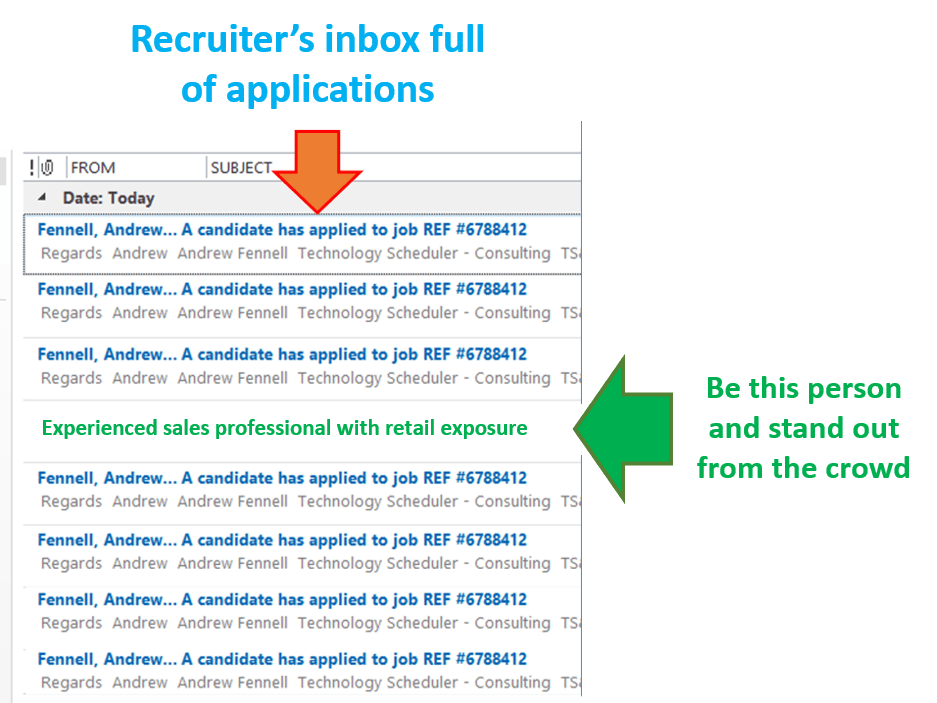
Use the subject line to highlight your skills and experience in a short, screen-friendly heading: consider your key selling point as a candidate and find a way make it into your subject line. For example:
“Digital Copywriter with 7 years marketing experience”
“Solicitor with 15 years in property law”
Don’t forget that subject lines are short, so you only have around 30-35 characters to make use of.

CV filename
CVs titled “CV”, “new CV” or, worse, a random constellation of letters (CV_778778.pdf) will simply look messy and get lost amongst the other hundreds of CVs that a recruiter receives daily.

At the minimum, you want to include your first and last name when naming your CV file, and if you wish, you can also add a short word or phrase to add some further recognition. For example:
“[Full Name] CV”
“[Full Name] CV SEO Consultant”
Addressing the recipient
The best way to build a friendly rapport with a potential employer is to address the recruiter by name.
This means doing a bit of research… you should be able to find relevant names of recruiting managers on the company’s website, LinkedIn, or in the job description itself. If the recruiter’s name isn’t available, stick to a friendly ‘Hi’, and avoid overly formal, outdated terms such as “Dear Sir or Madam.” For example:
“Hi [recruiter name]”
Friendly opening
To make the best impression on the recruiter and encourage them to open your CV , it’s a good idea to appear friendly with a warm opening – the recruiter will probably open hundreds of CV emails every day, so a personalised touch will go a long way. Use warm greetings, such as:
“Hope you’re having a good week”
“Hope my email finds you well”
Don’t be overtly personal, however. A simple, friendly greeting should do the trick.
Job you are applying for
After your friendly greeting in your CV email, you want to highlight the job you’re applying for. This is important as recruiters will oversee several (potentially similar) job vacancies at the same time, so you want to make sure your application is going to the right place.
Use the full job title, and if the job title is vague, you can also add in the job reference number. For example:
“I am applying for the role of [precise job title], as advertised on [company website/recruitment website]”
“I would like to put forward my application for the role of [job title] as advertised on [company website/recruitment website]. Job reference number: [XXXXX].”
It isn’t always necessary to add the job reference number, but it can be useful if the company is advertising various similar roles, or several roles within the same department.
Introduction + suitability
In your introductory paragraph, you have a limited amount of space and time to convince the recruiter to open your CV.
It’s therefore important that you be as clear and concise as possible here: if you’ve already highlighted your experience in the subject line, now is the time to add more relevant information to persuade the recruiter why you’re a great fit for the role.
You should lead with your experience in similar positions, along with the skills and value that you could bring to the table. As always, try to keep your sentences short, easy to read, and informative. For example:
“With over 10 years of experience working in fast-paced, results-driven SEO environments, I have developed a skillset ideal for the role of [job title]. In a daily workday, I liaise with several B2B clients, providing digital strategy to companies both local and global as a marketing consultant.
I have proven to be successful in my work, having [give a recent example of success], and it would be a privilege to help grow [company name] in the same way.”
This example captures the attention of the recruiter by demonstrating value – the recruiter isn’t being forced to read a list of qualifications or generic degrees – instead, they are being given concrete information about how this person could help their company. This will encourage them to click on the CV to find out more about the candidate.
If you don’t have lots of professional experience , you can still make a great impression in your email introduction. The key is to demonstrate value – there’s no use in simply listing your A-levels, as this doesn’t help your candidacy stand out from others who might share the same results.
Instead, make use of the skills you’ve picked up throughout your academic and professional career, tailoring them to suit the job you’re applying for. For example, if you were applying for a job in an online news organisation or social media company, you could use the following example:
Example 2 (student no experience)
“With 2 years working as an editor for my university newspaper [Name], I developed a rich understanding of the editorial process and experienced first-hand the demands of a fast-paced newsroom. During my period as editor, we broke various stories about university staff pay cuts and student living standards, while increasing our online subscriptions by 250%.”
While this example doesn’t demonstrate a professional job history, it shows the positive impact you had in an organisation where you worked, created engagement, and demonstrated initiative. You can apply this to any extra-curricular activity or volunteer program if you don’t have work experience, just make sure to research how this experience will serve you in the role you’re applying for.
Even as a student with no experience , you can still create a powerful email when sending your CV.
Reason for applying
Most companies and recruiters want to know that their employers will be in it for the long-haul: it’s therefore important to come across as both knowledgeable and passionate about the role and the company itself, demonstrating visible enthusiasm.
You can briefly cite the company’s values, the appeal of the job itself, as well as your overall suitability for the role as reasons motivating your application. For example:
“My experience in [field], combined with my alignment with [company’s] values, compel me to apply for this role. I believe that I have both the necessary skillset and personal drive required to succeed in this position.”
“I am putting myself forward for this role as I believe [company] would be an innovative and freethinking place to work, and I believe that I could contribute significantly to its success.”
By speaking to the values of the company, the recruiter will recognise that you either took the time to do your research (which demonstrates initiative and eagerness) or that you’re already familiar with the company – which employers love.
Availability
When it comes to your availability, you want to appear flexible and enthusiastic. Giving a recruiter a list of unavailable dates and times isn’t going to work in your favour here: simply indicate that you’re available at short notice for an interview.
Most recruiters will offer various time slots, so you don’t need to worry about being precise at this point. You can also add a call to action here, directing the recruiter towards your CV. For example:
“ Please find attached a copy of my CV . I am available for an interview at your earliest convenience.”
“I have attached my CV for your consideration, and I am free for an interview at short notice.”
Professional signature
Now that you’ve completed your CV email, you want to give the recruiter several options for getting in touch with you. The best way to do this is to have a professional signature: a professional signature looks like the below examples, and can be added as a footer at the end of all your emails:

[Full Name] Email: Phone Number:
John Peters Sales manager [email protected] Office: XXXXXXXX Home: XXXXXXXX
Sam Jones [email protected] Home: XXXXXXXX
Always make sure to use a professional email address. A recruiter is much more likely to take an applicant seriously if they have a professional email, and a lot less likely to reach out to someone asking them to contact them at [email protected].
Related guides: How to write a thank you email after an interview
Example CV emails
Check out some examples of effective emails below for inspiration and guidance:
Customer service

This customer service cover letter is short and to-the-point – it quickly delivers a host of reasons why this candidate would be valuable in a customer service role.
See also: sales assistant cover letter example
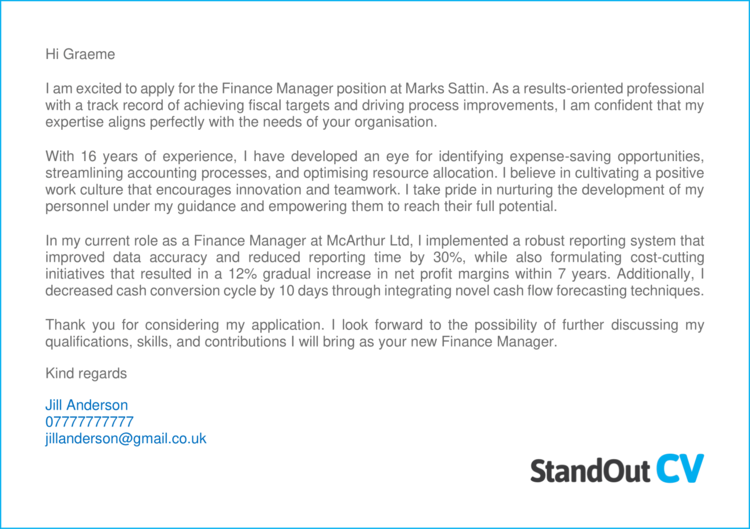
Applying for finance and accounting roles.
This cover letter outlines the candidate’s finance knowledge, and how they could apply it in the workplace
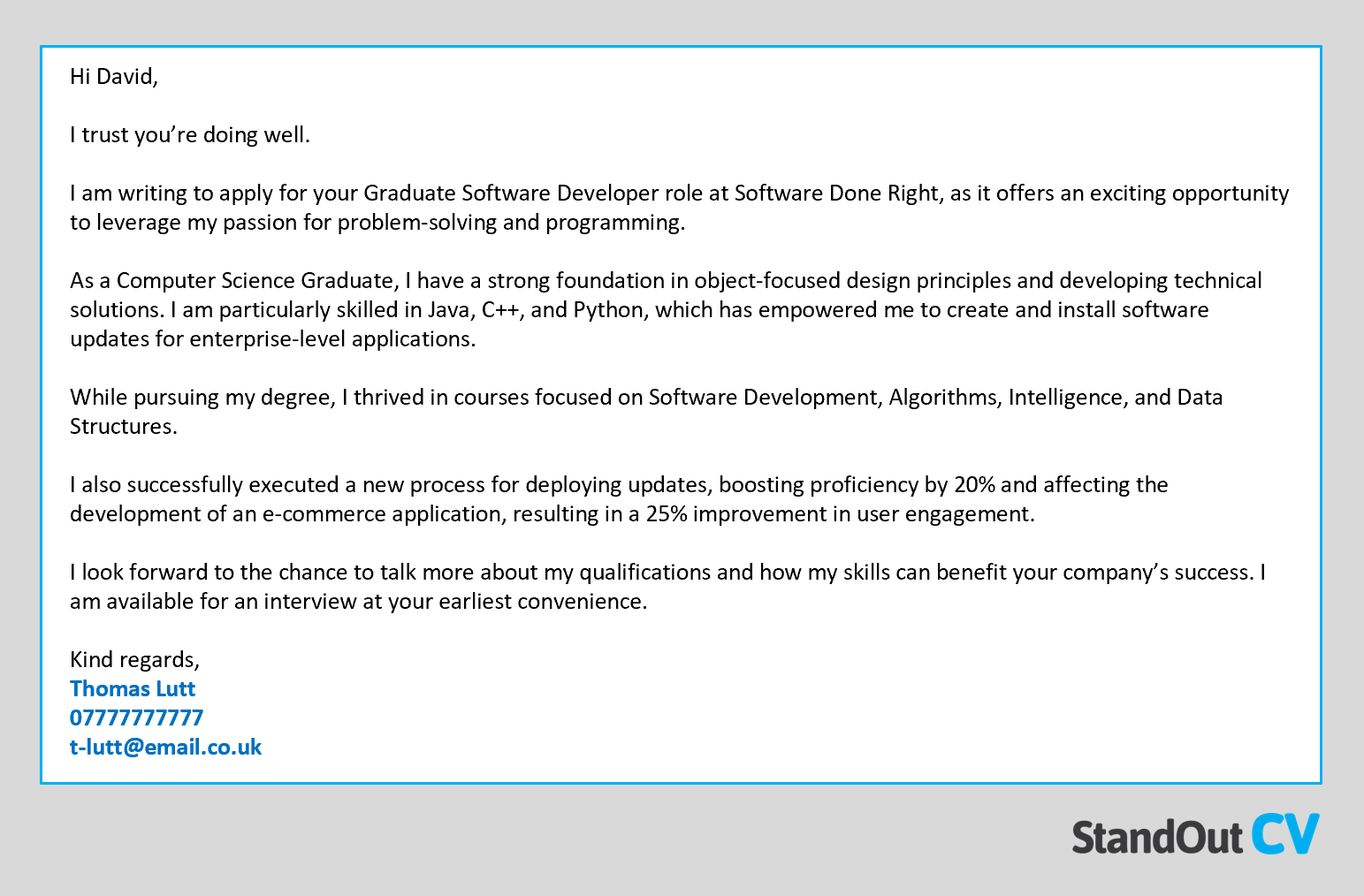
Graduate’s cover letters are a little longer than most, as they don’t have as much experience, so need to describe their education and transferable skills.
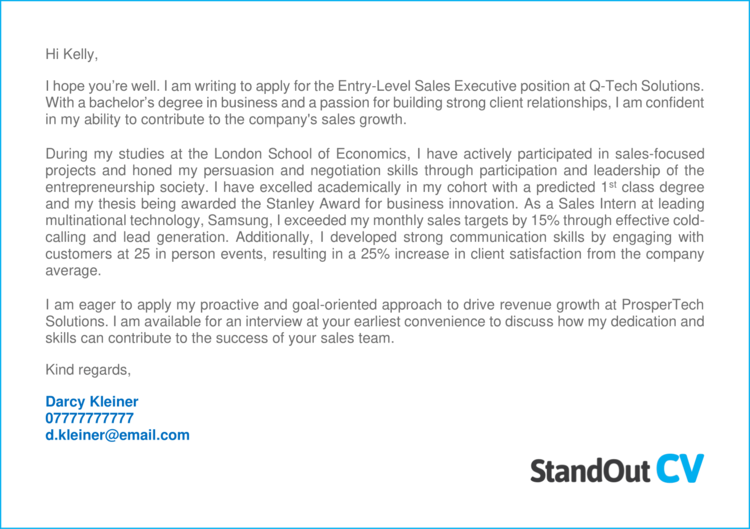
This cover letter boasts the candidate’s ability to make sales and drive revenue.
Protect your data
This site uses cookies and related technologies for site operation, and analytics as described in our Privacy Policy . You may choose to consent to our use of these technologies, reject non-essential technologies, or further manage your preferences.
- CV and Cover Letter
- How to email your CV: tips to...
How to email your CV: tips to getting yours read first
8 min read · Updated on April 17, 2024

What should your email look like when sending your CV?
If you're emailing your CV to a company, it's important to get everything right. Since this is your first interaction with a potential employer, you'd want to get off on the right foot and make a positive impression. So, how can you hit the mark?
Emailing your CV – top tips
It's essential to follow the job application instructions when emailing your CV. Employers are generally quite specific in what they want to see included in CV email applications (e.g. subject line, recipient, format, etc.). It's smart to play by their rules if you want to avoid being eliminated in the first round.
For roles where specific instructions are not set out, we recommend the following tips when emailing your CV:
1. Format your CV and cover letter correctly
Name your files succinctly and clearly. This is the first time an employer will encounter you, making it all the more important for your materials to be both professional and easily identifiable.
Here are some filename examples:
Joe-Bloggs-CV.docx or Joe-Bloggs-Cover-Letter.docx
Joe_Bloggs_CV.docx or Joe_Bloggs_Cover_Letter.docx
Always send your CV and cover letter in the format the employer asks for. Before choosing your file format , read the job description thoroughly to see if the employer prefers a certain file type.
Otherwise, there's no clear-cut answer for which format is best for emailing your CV. Generally, the best CV format when emailing your CV is a Word document (in .doc or .docx format). A PDF is often acceptable, but they're not always compatible with applicant tracking system software , making it hard for employers to properly read your CV.
2. Perfect the subject line of your email
Recruiters receive hundreds of emails every day. Be sure to write the perfect subject line when emailing your CV to ensure that it ends up in the right place and grabs the recruiter's attention.
The key to getting this right is keeping it simple. As such, your email subject line should include a combination of the following elements:
Vacancy or job title
Your first name and surname
Reference number or Job ID (if specified)
Additionally, don't try to be clever when it comes to this part of your application. Writing something snazzy like “I'm the best candidate” might not have the effect that you imagine. Of course, in some cases, the job advertisement will be clear about what you should include in the subject line.
3. Send a short message with your CV
If the employer has asked you to attach your CV and cover letter, the body of the email shouldn't duplicate the content of these documents. In this case, only write what's relevant and keep your email brief, reiterating the job you're applying for and the value you'd add to the company. More importantly, make sure that your CV and cover letter are attached for their review.
If the prospective employer has only requested a CV as an attachment, it's a good rule of thumb to also attach your cover letter. Treating the body of the email as your cover letter can be tricky since it ends up looking like a wall of text. Unless the advert says otherwise, don't do this.
4. Outline the purpose of your email
Hiring managers aren't exactly flush with time. When you're emailing your CV to them, open your message politely and get straight to the point. The first line of your message needs to let them know what the purpose is. That way, they will instantly understand what they can expect from your email.
Here's an example of how that might look:
“Dear Mr. Smith,
I am writing to you to apply for the advertised role of Content Writer at Handsworth Associates.”
When you've outlined the main point of your email, you can add in why you think your experience makes you the ideal candidate for the job. However, you should avoid repeating the content of your cover letter, especially if this will be attached to the email itself.
5. Include a call to action at the end
Finish your short message with a call to action. For example, you can say you're eager to meet in person to discuss how you can contribute to your prospective employer's success, suggesting your availability for a screening call or interview.
Take the time to carefully proofread your message and CV before you send them. If your email is packed with a bunch of spelling mistakes and grammatical errors, the hiring manager won't be impressed.
6. Don't forget your email signature
It's important to add an email signature featuring your contact details so the recruiter knows how to get in touch with you at a glance. In your signature, include the following:
Your full name
Your contact details
Link to your website or professional page
If you have any business-related social media profiles, such as a LinkedIn profile , include it in your signature as well. You can use hyperlinks so that they are clickable.
7. Attach your CV and cover letter
Once your email message is ready to send, you need to attach your CV and cover letter to your message. In most cases, you can do this by clicking the paperclip symbol or the word “Attach.” Don't miss this vital step of the process – you don't want to end up looking foolish or awkwardly emailing the hiring manager again just to send these.
8. Always send a test message first
Before you click “Send,” send a test message to yourself to be sure the email message is perfect and that all your attachments come through. You may also wish to send a copy of the message to yourself for your records by adding yourself as a BCC (blind carbon copy) recipient.
Emailing a CV – template
Following our tips above, here's an email template that you can use when sending a short message with your CV:
Email subject options:
[Position] application | [Your full name]
Application for Job [Job ID] | [Your full name]
[Position] application | [Job ID] | [Your full name]
Dear [Name of hiring manager / Sir/Madam],
I am writing to you to apply for the [position] vacancy in your company. With a background in [cite relevant skills or experience specified in the job advert], I believe that I have the skills necessary to contribute effectively to your team.
Please see my CV and cover letter attached for your review. If you need any other additional information, please let me know.
Thank you for your time. I look forward to discussing my application in more detail with you.
Kind regards,
[Your full name]
[Mobile number]
[Website or LinkedIn profile link]
FAQs on emailing a CV
Did we miss something along the way? Before you go about sending your CV to the hiring manager, check out our frequently asked questions:
When is the best time to email an employer?
The earlier, the better. So, try to email your CV during the start of the week and in the morning when recruiters will also be actively reviewing their emails. While there's no hard and fast rule, you should always take into account the work-week hours.
For example, you don't want to send your CV to an employer during the evening or weekend. While this may work best for you, it doesn't look the most professional. You can schedule your email to send during the right time the next day.
Do you attach a cover letter or write it in the email?
When you're emailing your CV to a company, your cover letter is oftentimes sent as an attachment too. However, there will be times when a short email message will do the trick. For instance, if the job advertisement specifies that you only need to send an email with your CV, just do that.
How do I get my CV noticed?
Creating a clear and concise document is the way to go. The content of your CV is just as important as how it looks. Apart from using a minimal design, make sure to tailor your CV to the job vacancy . When the hiring manager looks at your CV, they should be able to navigate the document easily and learn everything that they need to know about you quickly.
Manners matter too. The hiring manager will be looking at every element of your application. Getting the tone and approach right will help you to win them over before they even meet you in person.
Get ready to email your CV
When you're applying for a job via email, you want to make sure that your CV gets read first (and fast!). Remember to keep your message and attachments clear and complete when emailing your CV. That way, you remove any potential barriers for the hiring manager, instantly boosting your chances of your application being read and – ultimately – landing that job interview.
But before emailing your CV, why not make sure that it's up to par too? Submit it for a free, confidential CV review and we'll tell you where you stand.
This article was originally written by Laura Slingo and has been updated by Charlotte Grainger.
Recommended reading:
How to submit your CV: 14 questions to ask before sending
What should a cover letter include? Start with these essentials
When to follow up on a job application (and examples of how to do it)
Related Articles:
Professional CV writing service cost in 2024
How to choose the best CV paper
Craft a winning personal statement for your CV to stand out
See how your CV stacks up.
Career Advice Newsletter
Our experts gather the best career & CV tips weekly. Delivered weekly, always free.
Thanks! Career advice is on its way.
Share this article:
Let's stay in touch.
Subscribe today to get job tips and career advice that will come in handy.
Your information is secure. Please read our privacy policy for more information.
How to Email a Resume to an Employer [Template + Examples]

3 key takeaways
- Before you email a resume, consider seven best practices.
- Follow five steps when writing a resume email.
- Teal’s AI Resume Builder and Job Tracker with Email Templates can help you create a resume and email for every stage of the application process.
While today’s job application process typically starts in an online portal, it’s sometimes beneficial to email your resume and cover letter.
In this guide, you’ll learn how to email a resume in ways that increase your chances of progressing in the hiring process, including:
- Tips on how to email a resume
What to write in an email when sending a resume
How to follow up on your resume email.
- Resume best practices
Struggling to land interviews with your resume? Get started with Teal’s AI Resume Builder for free.
How to send a resume email
When you email your resume and cover letter, you’re pitching yourself for the job.
Here are some tips to keep in mind when preparing an email to a recruiter or hiring manager:
- Use a professional email address. Avoid sending your resume using an email you created when you were 15. Don’t use one that includes anything unprofessional. Your email address should be your full name, or a variation, so you’re clearly identifiable.
- Pick an optimal send time. You want to be at the top of the hiring manager’s inbox. That’s why early morning is the best time to send a resume email. If you’re working on it during other hours, consider scheduling the email. Gmail allows you to do this easily.

- Choose the right day. Let’s be real. Most people are busy on Mondays and winding down on Fridays. So your best bet is to send your email Tuesday through Thursday.
- Follow instructions. Some job listings have specific instructions on how to email a cover letter and resume. Some even request you include a word or phrase in the subject line. Your ability to focus on the details and follow instructions properly can set you apart.
- Double-check. Typos happen and so do other digital mishaps. Use a tool like Grammarly to spell check and ensure your grammar is correct in your email, cover letter, and resume. Open your cover letter and resume and make sure the formatting looks good. Put the email address in last so you don’t accidentally send an incomplete email.
Pro Tip: If you accidentally send an incomplete email using Gmail, you’ll see that your message has been sent and the options to “Undo” or “View Message” in the bottom left. Click “Undo” right away to unsend your email.
These email best practices can help you start on the right foot. This is your first interaction with a company and you want to give a positive impression.
How to email a resume (7 tips)
Emailing a resume may seem simple, but there are nuances to consider when applying to a specific job.
Here are top tips for sending a resume via email:
1. Create a well-optimized and formatted resume
Resume creation is one of the most important things job seekers need to focus on. Your resume needs (not should) to be well-optimized and formatted. That means two things:
- Tailor each resume to match the job position
- Your resume is scannable and easy to read
Using a resume template that fits your needs can help simplify the process. Teal offers a variety of templates to choose from, so your resume is easy to read and you don’t have to worry about the design and formatting all on your own. That way you can include the required sections and format your resume based on your desired role. Create a perfect resume using resume templates .

2. Tailor your resume
Using Teal Analysis Mode and Matching Mode, you can easily create a well-optimized resume. Just enter the job description and get a Match Score on your resume. Plus, you’ll get keywords and tips for how to improve your resume so it can stand out.

Start by using Teal’s Resume Builder. Simply upload your LinkedIn profile or existing resume and get a customizable resume. From there, you can make changes and access the Analysis and Matching tools.
3. Prepare your resume for email
Your resume format matters. In a single document, you’re sharing highlights of your career journey and relevant skills. Choosing the right one can grab a hiring manager’s attention. Some common resume formats include:
- Chronological resume
- Functional resume
- Combination resume
These formats showcase information in different ways. Based on where you’re at in your career and the job you’re applying to, you can choose which format is ideal for your situation.
Once your resume is ready and your resume emails optimized, the question remains:
Should you send your resume as a Word or a PDF file?
People often wonder what’s the best format to send a resume. First, go back to the job listing and see if there are instructions on how to email a resume. Some listings might say which format they prefer. If there’s no preference listed it’s up to you. But there are some things to consider when deciding between sending a PDF or Word doc for your resume file.
Nicholas Hopkins, director and head of contract recruitment at VIQU IT Recruitment suggests using a Word Document for some important reasons:
"You'd be surprised, but people still include personal details such as age. If the recruiter is committed to upholding diversity recruiting, they may also need to remove information such as your name, name of your school or university, and start and end dates for job experience. This is to limit potential occurrences of unconscious bias. Some common mistakes I have found people make when emailing their resume are including pictures or not including information on how recruiters can contact them."
Scott Lieberman, founder of Touchdown Money hires people for his small business and has been on the HR hiring committee of various companies for over 10 years offers a different point of view:
“Use a PDF formatted resume to attach to the email. A PDF ensures your resume is opened with the same formatting as you typed it.”
So if you’re applying directly to a company, you might consider using the PDF format. You can feel confident that your formatting is intact. On the other hand, if you’re emailing a resume to a recruiter a Word Document may be a better option.
Ultimately, the type of file you send is secondary to the contents of your resume. Make sure your resume looks organized and legible and that it’s optimized based on the job description.
4. Write an effective email subject line
Emailing a resume won’t do much good if nobody opens the email. That’s where creating a clear and concise subject line helps.
Avoid these subject line mistakes when emailing your resume:
- Leaving the subject line blank
- Only putting “job application”
- Very long subject lines
Instead, keep the subject line simple using this formula:
[Full Name Application]: [Adjective] [Job Title] [Seeking New Opportunity at] [Company Name] [Job ID if available]
Email subject line examples :
Brad Smith Application: Collaborative Software Engineer Seeking New Opportunity at Google #530 Katie Johnson Application: Results-Driven Social Media Manager Seeking New Opportunity at Buffer Jerry Johnson Application: Dynamic Program Director Seeking New Opportunity at LA Phil
That’s the basic formula. You can tweak it to your liking, but leading with the most important details can make sure it’s not overlooked or confused for spam or promotional email.
Remember, companies may be hiring for multiple positions, so listing the job title can be helpful. Including your name makes it easier to search and listing the company name makes it specific. Lastly, adding an adjective and verb can give them a taste of who you are and what you can do for the company.
For more tips on crafting an effective subject line, check out this guide on email subject for job application.
5. Email the right person
To help your email stand out and be more professional, email the person most involved in the hiring process. If the hiring manager’s name is listed on the job description, use it when addressing your email. Copy and paste carefully to avoid any misspellings.
If you don’t see a name but there is a job title, do a little research and see if you can find the contact. For instance, find the company’s LinkedIn page and search through the employees for the title the role would report into or recruiting titles. If no contact details are available, use “hiring manager” or “recruiter.”
6. Give context
Don’t just shoot off an email saying “Resume attached!” An email is a short-form style of communication. It’s essential you lead with your point and why it matters to them. Don’t assume they’ll connect the dots, share concise context in the email and subject line.
Resume email example:
Dear Hiring Manager, My name is [Full Name] and I saw the [Job Title] position listed on [Website/Where you found it]. As a [Job Role] with [X years of experience], I’d love to be considered. Attached you can find my resume and cover letter. Thank you for your time and I look forward to hearing from you. Sincerely, [Full Name]
7. Optimize and attach the resume file
Your resume should be 10 MB or less. If your PDF file size is too large, use a compression tool to make it smaller. It should be small enough to send without compromising on quality or the ability to read it. It’ll be of no use if someone downloads your resume but can’t read it properly.
Additionally, your resume file name should be clear and include your name, job position, and company. Instead of a jumble of non-descript numbers and letters, it should look something like this:
BradSmithResume_SoftwareEngineer_Google BradSmithSoftwareEngineerResume_Google BradSmith_SoftwareEngineerGoogle
Having a clear naming convention can make it easier to find your resume for all parties involved. It also shows you’re being specific and applying for a particular role at a company, instead of sending off the same resume to several companies.
When you’re about to attach your resume to your email, do so carefully. You don’t want to send the wrong attachment or the wrong version of your resume. You can be extra careful and send yourself a test email with your resume.
Here’s how to send an email and attach your resume in Gmail:
- Log in to Gmail
- Click on the “Attach files” icon (look for the paper clip at the bottom of your email)

- Select your resume
- Press “Open”
After following those steps, your email should have the attached resume ready to send. Teal can help you create various versions of your resume and ensure it’s the right file type.
Consider emailing a cover letter
While emailing your resume, you should consider emailing a cover letter as well. If this is in the job listing, this is a must. Even if it’s not a requirement, attaching a cover letter can provide more context about your experience and bring your resume to life.
The key is to include your cover letter as another attachment. Many people copy and paste their cover letter into the email body or combine it with their resume file. This should only be done if instructed to do so. It’s better to keep your message short and sweet and provide all job application materials as attachments.
This makes them easier to download and share with other staff members. It’s also just a cleaner and more organized way to apply for a job.
Here’s a step-by-step guide on what to write in an email when sending a resume.
Step 1: Address the hiring manager or recruiter
Your email should start with a friendly salutation like “Dear” and the email recipient. If you have the contact’s name, use it so it’s clear and personal. When there’s no name given, you can use hiring manager or recruiter. Avoid writing “To whom it may concern” which feels impersonal.
Dear Hiring Manager, Dear Recruiter, Hiring Manager, Recruiter,
Step 2: Write an intro
Your intro is where you set the stage. You’re establishing your reason for contact. Write clearly about your intentions and the purpose of your email. Here are some examples of several different situations and how to send a resume through email.
If inquiring about a job
I’m reaching out about your [job title] position listed on [website] and would love to learn more.
If applying for a job
I saw your [job title] posting on [website] and I’m interested in applying.
If following up on a job
I wanted to follow up about the [job position] at [company]. Please let me know if there are any updates.
Step 3: State your purpose for emailing
The body of an email is where you get to the heart of the matter and provide more details.
I’m interested in the position and would love to know the best way to apply and submit my application.
After reviewing the job description, I believe my skills and abilities would benefit your organization. I’ve attached my cover letter and resume for review.
I’d love to meet with your team to discuss my experience further.
Step 4: End the email
The close of your email should remind them of your interest in the position—and have a dose of enthusiasm and gratitude so you leave a positive impression.
I look forward to hearing back from you and learning more about the opportunity.
I would love to discuss how my experience can be an asset in this position. Thank you for your time and consideration!
Let me know if you need anything else or have any questions.
Step 5: Sign off
Your sign off can include “Sincerely” or “Best” and list your contact information.
Example sign off :
[Full Name] [Email] [Phone Number] [LinkedIn profile, optional]
Tips on writing a resume email
The salutation and signature are easy enough, but the body of the email is where you’ll get more specific. You want to keep your message clear and inspire a call to action, which in most cases is a response, an interview, or a job offer.
Tips to keep your resume email professional and concise:
- Keep it brief
- Don’t reiterate what’s in your cover letter
- Avoid sharing too much of your resume in the body of the email
- Aim for three to five sentences
- Don’t copy and paste your cover letter in the body, unless instructed to do so
Teal’s Email Templates feature can give you a head start. Inside the Job Tracker , you'll find email templates for applying for a job, following up on an application, following up after an interview, and even resigning from your job , and giving two weeks notice . That way, you don’t have to start from scratch or reinvent the wheel, so you can use your time elsewhere.
After sending an email with your resume and cover letter, the waiting game starts. It can be nerve-wracking, but there is one thing you can do (sparingly) to feel a little more in control—follow up.
The art of email follow-up is crucial. You want to be enthusiastic but not too eager. Polite and not pushy. To follow up, send a well-written email using the email address you used to send your application materials.
Example follow-up email:
Dear [Hiring Manager’s Name], Hope you’re doing well! I submitted my resume and job application materials for [job title] a few weeks ago. I wanted to check in and see if you have any updates on the hiring process. I’d love to chat with your team further about the role. Best, [Full Name] [Contact information]
Sending a follow-up may help you get a response so you know where you’re at in the process. It’s also about taking a proactive approach to your job search. In fact, some hiring managers expect interested candidates to follow up after an interview. That said, don’t overdo it. In most cases, you should wait until they respond before checking in again.
What NOT to do when sending a follow-up email after applying for a job:
- Use a different email than the one you used for your application
- Send an email too soon (wait a minimum of a week, but two to three weeks might be better)
- Be demanding
- Forget to include your contact information
- Fail to mention the specific job posting
For a detailed breakdown on following up on an open role, check out this guide on how to follow up on a job application .
Create a resume you’re proud to send
Learning how to send a resume the right way can mean the difference between getting a response and getting lost in the void. When applying for a job, communication matters. The way you send an email, what you say, how you say it, are all considered before you get an interview.
So make sure your message gets your point across with an optimized resume that’s named properly and attached to the email.
To help you feel confident and create a resume you’re proud of sending, use Teal’s Resume Builder. Importing your LinkedIn to create a resume has never been easier and using the range of templates can help you design something that feels like “you.” Also, see how your current resume matches the job description, so you can make improvements and boost your chances of a callback.
Using both the Resume Builder and Email Templates feature is a winning combo that can remove some of the pain of creating a resume and sending professional emails.
Sign up for Teal today to access resume and email templates.
Frequently Asked Questions
What should i write in an email when sending potential employers a resume.
In an email sending your resume, write “My name is [Full Name] and I’m interested in applying for [Job Title] at [Company Name]. Given my [years of experience], I think I’d be a great fit for this role and would love to talk further. You can find my resume and cover letter attached to this email. I look forward to hearing from you and discussing this further.”
How do you professionally say my resume is attached?
When sending your resume via email, let the email recipient know which documents are attached by saying “My [resume, cover letter, etc] are attached to this email for review.
Is it okay to email your resume?
You always want to follow the instructions provided by the company in the job listing. If the job posting states that you should send your resume via email, it’s not only okay but also necessary to follow those instructions. Other companies may prefer you use their job portal or other online method to submit an application.
Does it matter what time you email a resume?
When you send a resume matters. It’s ideal to send it first thing in the morning so it has a better chance of being seen. This may help your email stay at the top of the inbox instead of getting lost among unread emails. If your email provider allows it (Gmail does), schedule your email to send the next morning if preparing the email later in the day.

Melanie Lockert
Related articles.

How to Ask for a Letter of Recommendation (Templates + Examples)
.jpeg)
What is a Resume Builder?

Rezi Review: Ratings & User Feedback

We help you find the career dream.
Protect your data
This site uses cookies and related technologies for site operation, and analytics as described in our Privacy Policy . You may choose to consent to our use of these technologies, reject non-essential technologies, or further manage your preferences.
- CV and Cover Letter
- What to Say When Emailing a...
What to Say When Emailing a Resume (with Examples)
10 min read · Updated on January 11, 2024

Introduce yourself professionally when you email your resume
You've written the perfect resume and tailored it to the role you're aspiring to. What should you do next? A few years back, you'd have printed it off on some quality paper, addressed an envelope in your best handwriting, posted it off, and settled in to wait for a response. These days, though, it's more common to email your resume. It's faster, it's more professional, and it's easier to share a file than a printout.
But if you're going to email your resume, what should you say? Should you attach a cover letter? How much detail should you include?
So many questions!
But fear not, TopResume is here to help you decide what to say when emailing a resume, and we have answers to all these questions and more. Settle in as we guide you through it.
Should I email my resume?
Yes! It's absolutely fine to email your resume when you apply for a job. In fact, it's usually preferred to printed correspondence these days. Of course, the most important point is that you should follow the instructions on the job posting. If it requests a printed resume or a resume uploaded via an online portal, you should definitely apply in line with those instructions. However, if there are no specific instructions, an email application is advisable. Just make sure you're addressing it to the right person!
General rules for emailing your resume
Before we get into the specifics, let's refresh on some general guidelines for emailing your resume to a company. After all, first impressions count, so using proper email etiquette is important.
Use a professional email address. “ HotLips69@...” may have seemed cool and funny when you set up the account, but does it really convey that you're a credible professional? If necessary, set up a new email account to use for job applications – and remember to check it regularly for responses!
Add a clear subject line. Make the point of your email clear with a logical subject line – you could include the job title of the vacancy you're applying for, for example, or refer to the fact that the email is a job application or resume.
Choose a professional greeting. Think “Dear [name],” or even just “[name],” rather than “Hiya” or “Greetings.” While email is less formal than a letter, you still need to keep the tone professional.
Be concise. Short, snappy paragraphs are easier to read on a screen, and no one wants to trudge through pages of waffle to find the information they need. Respect the reader's time by keeping it simple.
Add a formal sign-off. A version of “thank you” and your name is sufficient – you may also want to add your professional title, a contact number, and a link to your portfolio if you have one.
Don't forget the attachments! Make sure that you've actually attached your resume (and your cover letter, if required). Ensure they have sensible file names, too: “Jay Miller – Resume” or “J Miller – Sales Executive Resume” is more professional and easier to retrieve than something like “JM 010224 v3” or simply “Resume.” Also, double-check the file type that you're sending – check out our article Word vs PDF if you're not sure.
What to say when emailing your resume – the detail
So now we've reviewed the basics of email etiquette, let's get down to business. You need to know what to say when emailing a resume. Well, the exact wording will vary depending on the situation, the role, and your personality, but you'll certainly need to include the following:
Why you're emailing
Your reader may have a ton of open vacancies and is likely to receive many resumes for each one. Make their life easier by clearly stating the role you're interested in applying for. If you have a reference number for the vacancy, you can include that too.
Your elevator pitch
Briefly explain who you are , what you do, and why you're the right person for the open role. This doesn't need to take up a lot of space or be very detailed – the key thing here is to be convincing enough for them to want to open your resume document to find out more. Include whatever information is most pertinent to the role – that could be your academic qualifications, your industry experience, awards and accolades, or particular skills. Refer to the job posting to find out what the company wants to see in a successful candidate and ensure the requirements are reflected in your email.

A call to action
Encourage the reader to open your resume, reach out with further questions, or schedule an interview. This one little line can show your enthusiasm for the role, emphasize your professionalism, and prompt your reader to take the next step in progressing your application.
What to say when emailing a resume – sample messages
Do you need a bit more inspiration to craft your message? Take a look at these sample emails and use them as a frame for your own resume email. Remember, the job advert is your cheat sheet when it comes to deciding what details to prioritize here.
What to say when cold emailing a resume
To: Katie French
From: Matthew Cole
Subject: Sales resume
I've long admired XYZ Inc. as a leading supplier of home tech solutions and have heard many positive reviews about your company as an employer. To that end, I am attaching my resume in the event that a sales vacancy may soon arise.
As you can see, I have enjoyed a successful 10-year career in technology sales and am a committed user and advocate of your products. This year, I am on track to exceed my sales target by 46%. I would bring an extensive network of industry contacts and a proven ability to motivate sales teams to surpass expectations.
If there are no suitable vacancies at the moment, please feel free to keep my resume on file for future reference. I look forward to hearing from you soon.
Matthew Cole
Sales Manager, Acme Products
What to say when emailing a resume in response to a job posting
Subject: Sales Executive vacancy (Ref: ABC123)
In response to your advertisement for a Sales Executive, I am attaching my resume. As you can see, I combine eight years of sales experience with a degree in Marketing and three awards for excellence in sales roles.
The advertised role is particularly interesting to me, as it will allow me to leverage my expertise in technical sales, provide the opportunity for international growth, and establish trusted relationships with your clients to open new avenues for revenue and increased sales.
Please don't hesitate to reach out to me if you have any questions; I look forward to discussing my suitability further with you at an interview.Thank you for your consideration,
Sales Executive, Acme Products
What to say when emailing a resume to a recruiter
Subject: Healthcare Roles
Dear Katie,
I saw on JobBoard.com that you are recruiting for several healthcare roles, and would like to submit my resume for your consideration. I combine 10 years' experience as a Healthcare Assistant with numerous industry certifications and consistently receive positive patient feedback.
I look forward to hearing from you,
What to say when emailing a resume to follow up on a conversation
Subject: Finance Manager follow-up
Following our phone discussion earlier today, I would like to reiterate my interest in the Finance Manager position and attach my resume for your consideration.
As you can see, I am currently fulfilling the Finance Manager role at XYZ Company and am looking forward to developing my career within a global organization. I have a master's degree in Business Administration, as well as extensive experience in managing the finance function within a security business. I look forward to bringing my leadership skills to your team of finance experts.
Please reach out to me at 555-555-5555 when you have had a chance to review my attached resume.Regards,
Finance Manager, XYZ Company
What to say when emailing a resume following a referral
Subject: Events Manager vacancy
Dear Ms French,
Please find attached my resume. I have been referred to the Events Manager position by one of your colleagues, John Day, who I previously worked with at ABC Inc. Having delivered many successful events with John as my manager, I'm flattered that he has now asked me to apply for your open role.
I've recently delivered a conference for 800 international delegates and a team building event for 5 national teams, both of which were very well received and were completed within challenging budgets. I am confident that I can bring a similar level of client satisfaction to DEF Inc. and look forward to discussing the position further with you.
Please don't hesitate to get in touch to schedule an interview at your convenience,
555-555-5555
Should you attach a cover letter when emailing a resume?
Now we've covered what to say when emailing a resume, it's time to consider the cover letter. As you can see, we recommend that the body of the email be kept short and concise. If you feel the need to include more detail, you can consider attaching a cover letter as well as a resume. There's no obligation to do this unless a letter is specifically requested as part of the application instructions, but it does give you the opportunity to expand on key points of interest.
Top tip: You may like to read our article on how to write a cover letter to make sure you get this part of your application bang on!
How long does it take to hear back after emailing a resume?
Don't panic if you don't hear back immediately! While email is a speedy way to apply, recruiters and hiring managers receive many resumes for every open role and need time to sift through them, create shortlists, and schedule interviews. That said, certain recruiters have a reputation for ghosting unsuitable candidates, or your application may simply have been overlooked, so there's no harm in following up after a week or two if you haven't heard anything.
What to write in a follow-up email
Subject: Communications Assistant vacancy (ref: 12345)
I emailed my resume to you last week in response to your advertisement for a Communications Assistant. I just wanted to check that you'd received it, and to reiterate that I remain very interested in the role.
If you didn't receive the resume or have further questions regarding my application, please do get in touch with me either via email or by phone at 555-555-5555.
Email with confidence
Now you know what to say when emailing your resume in any situation, you're ready to apply for your dream job! Use this checklist to make sure you've nailed it before you hit the send button:
Correct email address and personalized greeting
Appropriate subject line
Clarification of the role you're applying for
Elevator pitch
Call to action
Professional sign-off
Attachments attached
Final proofread
If you feel that your resume isn't quite ready to be unleashed upon the world, why not get an expert opinion? Our free resume review will explain which areas need further work before you submit your application.
Recommended reading:
How to Write the Perfect Goodbye Email to Co-Workers & Clients
The Networking Email That Works Every Time
How To Use AI To Prepare For A Job Interview
Related Articles:
Guide to Writing a Great Resume with No Work Experience
How To Write a Sick Leave Letter (with Template and Example)
How to Write a Letter of Recommendation
See how your resume stacks up.
Career Advice Newsletter
Our experts gather the best career & resume tips weekly. Delivered weekly, always free.
Thanks! Career advice is on its way.
Share this article:
Let's stay in touch.
Subscribe today to get job tips and career advice that will come in handy.
Your information is secure. Please read our privacy policy for more information.
Flow through your inbox
Flowrite turns your instructions into ready-to-send emails and messages across your browser.
.png)
For companies
Nov 9, 2022
How to write a professional job application email with 6 samples and templates
Your email can make or break your job application. Here we explain the process for writing an effective email for a job application.

Lawrie Jones
Table of contents
So, you’re looking for a job and you know that a critical part of your success will be your email application.
In this guide, we explain the process for writing an effective email for a job application. We don’t stop at the first application but provide examples of several follow-up emails for job applications after no response here .
Follow the advice, and you’ll stand the best chance of getting the job of your dreams (or something to fill the time until that comes along).
How to write an email for a job application
The average recruiter receives 250 applications for each post and spends no more than 7 seconds scanning your message (about the same time it takes to tie your shoes).
The key to success is standing out. That doesn’t mean trying to be witty or wacky, but being a pro is the same process you must use through all job application follow-up emails.
What you need to apply to a job via email
Let’s clarify what a job email is. It’s not a cover letter or a CV but a mechanism to deliver them.
Some people don’t bother to spend much time on an application email but get your application email wrong, and the recruiter may not even bother to read your resume or open your application letter.
Why? Because if they’re dealing with 250 responses, they’re actively looking for reasoning to exclude applications – so don’t let that be you!
Each recruiter has their own application process, but there are some pretty standard things that you’ll need to include with every application, including:
- Cover letter
- Work samples (optional, but a nice extra!)
Here's a brief explainer if you don’t know what these are.
1. Cover letter
Your cover letter is a formal part of the application process where you introduce yourself, describe your skills, why you want the job, and what value you can add for the business.
We’re not going to walk you through how to write a cover letter. However, there are some amazing online resources , so start there.
You can attach your cover letter as a Word document or PDF. It’s essential to use a file that can be downloaded, printed, and shared – so avoid using Google Docs or cloud software.
2. CV (resume)
Your CV is the story of your working life, a snapshot of your skills, and a chance to highlight your achievements. Again, we’re not going to explain how to create a compelling CV , but we recommend using a simple, easy-to-read, and understandable template.
Again, don’t try to be fancy with formats – create a document that can be downloaded, printed, and shared.
3. Samples of work (optional)
As the experts say, “show, don’t tell.” You can use your application email to showcase your skills and previous results. You can attach a portfolio, photos, or videos or provide a link to your website or social media in your email.
Some tips from us are to introduce examples and explain the impact. Who cares if you designed a great-looking poster? But if that poster boosted sales by 50%, that’s a different matter.
The second piece of advice is only to include a few examples (3 is a great number). Too many appear desperate.
Thirdly, only share work that’s 100% yours. If you worked as part of a team or an organization, make your role clear. Never claim other people’s work as your own.
Finally, be prepared to answer questions on these examples at your interview – including what you did in the process.
Best job application email tips
We’re all about providing information, advice, and terrific tips to help you get ahead of the competition and secure that essential interview.
Here are 7 job application email tips. (Why 7? Because that’s the world’s favorite number , and we couldn’t think of 10.)
1. Send your application email and CV for review
Tip number 1 is the most critical. After proofreading at least twice (or eight times), send your job application email and CV to a friend, colleague, parent, or mentor – or all of them – and ask for feedback, comments, and suggestions.
Your email will give the first impression, so make sure it’s personal, professional, formal, friendly, and favorable.
2. Make a convincing pitch in the email body
Remember that hiring managers, executives, and founders are busy and will not often open or read your full CV. So you’ll need to convince them in the email body that it’s worth their time to read further.
Think of your email as an advert for you:
- A persuasive subject line gets the attention (and may result in opened email)
- A compelling email body makes the recipient want to learn more (and may result in opened CV)
- Convincing CV makes the recipient want to contact you (and may result in an interview)
The most important thing is to reflect the language in the job spec. The recruiter has been straightforward about what they want and who they’re looking for. Using their language can help to establish that the person to fit the slot is you!
3. Make it easy to contact you
Even though you might have all the necessary contact information in your CV, please include them in the email. This reduces the steps between clicks and contact.
Here are some of the things you should include in every job application email: Use this
- phone number
- social media links (LinkedIn and Twitter)
- portfolio links (optional)
4. Use a professional email address
Sure, the email address you created when you were 12 or first started college was funny then but is it today? Unfortunately, the chances are it isn’t!
Make sure you have an appropriate email address for a job application. Creating a new email address doesn’t cost anything, and setting up alerts on your phone is simple, so why jeopardize your chances with [email protected] ?
(Don’t email this, we don’t know who owns it!)
5. Check the name of your resume file name
We’ve touched on the importance of using the correct formats for cover letters and CVs.
When you create your CV, give the file (Word document, PDF, or whatever) a professional name that can also be identified with you.
You never know where it might end up.
Here’s a formal naming convention: “Name - CV - Position,” for example:
- Arthur Shelby - CV - Binman at Shelby Company Ltd.
6. Use references if you can
Do you know someone who works or used to work at the company? Or do you know someone who knows someone who works or used to work at the company?
Warm connections are always better than cold emailing (even if it’s unfair). As the saying goes, your network is your net worth, so try to leverage it to your advantage.
7. Include social proof
Have you already done similar work for someone else? Show it!
Social proof is powerful and backs up the statements you may have made in your application email, cover letter, and resume.
Social proof also includes social channels. LinkedIn is used worldwide, so don’t be afraid to drop in a link to your profile. It also creates a connection, so even if you don’t get this job, you’ll be the first to know of the latest opportunities.
Job application email format
Job application emails aren’t the time to get creative or buck the trend. However, there’s an accepted format for all job application emails, which we break down below.
1. Subject line for job application email
What’s a suitable email title for a job application? You could go crazy and say, “I’m perfect for this job!!!” but that would be silly. Instead, the subject line for your job application email should be simple to read and easy to understand.
The traditional (and still best) approach is to state your name and the job you’re applying for (or a combination of that). Here are a few examples:
Applying for a job probably is the best place to get creative, so stick to a simple subject line for your job application emails.
2. Email greeting for job application
Your email greeting should be polite and professional. Examples of that include:
- Dear (an oldie, but a goodie!)
If you know the recruiter's name, then use it. People always love to receive emails addressed to them. One thing to avoid is the phrase “Dear Sir/Madam” or using formal titles such as Mr, Mrs, or Ms. We’ve got a whole world of possibilities, so it’s time we all moved on from traditional (old-fashioned) titles.
3. How to start a job application email
First up, state the purpose of your email.
- I am applying for the post of (job name)
Doing this means the person understands what the message is about – which will save them time. Also, in many cases, the person receiving the email won’t be the recruiter, so they can file it away and share it with the person (or persons) who need to see it.
After that, you’ll need to explain what you’ve included with the email (your resume, cover letter, and examples). It’s always worth providing at least a few positive sentences on the opportunity. Finally, you’ll need to include any requested information, such as salary expectations.
4. How to end an email job application
There are conflicting opinions on how to end an email job application. We recommend asking for information on the next steps. Here’s how this can work:
- Please can you provide me with details on the next steps in the process?
This leaves the recipient in no doubt that you’re serious about your application. If they reply, you’ll be reassured that they’ve received your application. Finally, you’ll know the timescales for decision-making, which removes the need to send a follow-up.
Always ask for the next steps in the process at the end of every email job application.
5. Email signature for job application
Sign off with your full name, phone number, and social media links (LinkedIn and Twitter), and attach your CV. Provide all information the recipient will need to contact and connect with you.
Job application email samples
We’ve talked a lot about the process; now, let’s put it into practice! These job application email samples cover 7 common situations you might experience when searching for a job. You’ll get a simple job application email sample, some application follow-up emails, and even how to withdraw an application if needed.
Use these job application email examples to start your job search, but edit and update them to suit your specific circumstances.
1. Simple job application email sample
This simple job application email sample can be cut, pasted, edited, and amended for pretty much any opportunity. It’s not exciting or innovative, but it provides a structured way to communicate the critical points you need to.
2. Email introduction for job application sample
The previous email sample covered how to apply for a job, this one is similar, but it’s about introducing yourself to the recruiter. This introduction approach is a great way to make a personal connection and can work well for several situations.
3. Job application status email sample
We’re clear that you should always ask for details on the next steps in the recruitment process, but as we all know, real life doesn’t always follow rigid plans. This job application status email sample is a way to politely push the recruiter to let you know what’s happening in the recruitment process.
4. Withdraw the job application email sample
Yes, there are some occasions when you might need to withdraw a job application, in most cases because you’ve got another job.
You don’t need to explain why you’re removing yourself from a recruitment process, but most people usually do (and we have in this withdraw job application email sample).
5. How to email HR for a job application update
When emailing the recruiting managers, you’ll need to be formal as they decide your destiny. On the other hand, HR teams deal with large volumes of applications, so this short message is fine. Here’s how to email HR for a job application update.
6. How to write an email to accept a job offer
Hooray, you’ve been offered a job; now it’s time to say yes. Here’s how to write an email to accept a job offer.
Job application email template
Flowrite's email template for job application.
There is no 100% right or wrong way to send a job application. But having an effective email template, using proper grammar, and email format will help, as you need to most likely send many, many emails to land your dream job.
This is where Flowrite comes in. Flowrite's AI-powered smart templates can help you craft better emails.
Our tool turns your words into ready-to-send emails, like this:
Final words on job application emails
In reality, you’ll need to send many job emails, follow-ups , and reminders to get a position.
It’s the way the world of recruitment works, and we know it can be frustrating.
But trust us, by investing some time crafting high-quality job application emails and persuasive follow-ups, you’ll stand the best chance of getting a perfect position.
Supercharge your communication with Flowrite
Write emails and messages faster across Google Chrome.
Explore Flowrite
.png)
Start using Flowrite today
Try it yourself
General template
Reply to: "
Received message
introduce flowrite short instruction to ready to send emails we finish email
Generate a reply
Generate an outreach
Share this article
Related articles
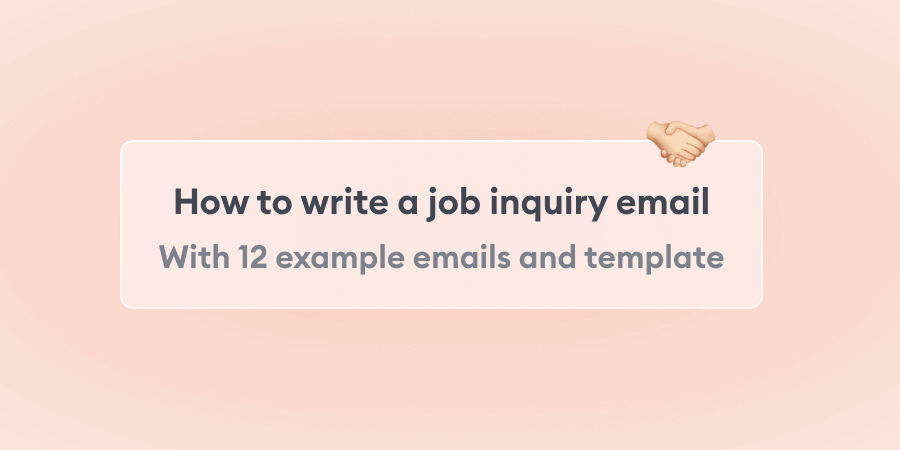
How to inquire about a job with 12 samples and a template
Here we show you process of sending a job inquiry email, including a list of the essentials you must include

How to write an email to a company with 4 samples and template
Here we help you draft professional, respectful emails to companies in easy-to-follow steps

How to follow up on a job application with sample and template
Following up on a job application after no response is a must. Here's how you do it.

We use cookies to analyze site performance and deliver a better experience for visitors.
%20(1).png)
Product updates
Read the latest →
%20(1).png)
About Flowrite
Get to know us →
Productivity

© 2023 Flowrite
- Search Search Please fill out this field.
- Career Planning
- Finding a Job
- Cover Letters
How To Email a Resume and Cover Letter Attachment
:max_bytes(150000):strip_icc():format(webp)/ADHeadshot-Cropped-b80e40469d5b4852a68f94ad69d6e8bd.jpg)
Ashley Nicole DeLeon / The Balance
Depending on the job for which you're applying, you may need to email your resume and cover letter to the hiring manager. That's often the case with smaller employers. For other employers, you'll apply online or via a job board.
What's the easiest way to attach your resume and cover letter to an email message? When you're asked to send a resume or cover letter via email, follow these steps to ensure you have correctly attached your documents, written an email explaining what you are sending and why, added your signature to the email, and included a subject line that will get your message opened and read by the recipient.
Key Takeaways
- Most employers request a Microsoft Word document or a PDF file of your resume.
- It's easy to save your documents in the file format requested by an employer.
- When saving your documents, use your name as the file name.
- Include a subject line that states who you are and what job you are applying for in the email message.
Check the Employer's Instructions
When you apply for jobs via email , the employer may require you to send your resume and cover letter as an attachment to an email message. It's important to send your attachments correctly, to include all the information you need so your email message is opened and read, and to let the receiver know how they can contact you to schedule an interview.
What's most important is to follow the employer's instructions and send exactly what they have asked for in the format it's requested. If you don't, your message may end up in a spam or trash folder.
Save Your Cover Letter and Resume
When sending your cover letter and resume attachments, the first step is to save your resume as a PDF or a Word document . The job posting should specify how to send the attachment. This way, the receiver will get a copy of the resume in the original format.
If there aren't instructions on how to send your documents, submit your resume as either a Microsoft Word document (.doc or .docx) or as a PDF file. These are the formats most commonly preferred by employers, and it's easy to save the documents and add them as attachments to your email message.
You can either save your cover letter in document format or write it directly in the email message.
Save as a Word Document
If you have word processing software other than Microsoft Word, save your resume as a Word (.doc or .docx) document. File > Save As , should be an option in your program.
Save a Google Doc as a Word Document
If you don't have Microsoft Word, you can save a Word (.docx) version of a Google Doc. Select File > Download and choose Word Document (.docx).
How to Save as a PDF
Whether the employer requests a PDF file or you opt to send a PDF, here's how to convert a document file.
To save a Word document as a PDF:
- Select File > Save As in Microsoft Word.
- Select PDF from the Format drop-down menu.
To save a Google Doc as a PDF:
- Select File > Download and choose PDF Document .
Choose a Unique File Name
When saving your document, use your name as the file name , so the employer knows whose resume and cover letter it is, i.e., janedoeresume.doc and janedoecoverletter.doc.
Don't use "resume" as a file name, because it will be hard to differentiate your resume from those of the other applicants.
Include a Subject in the Email Message
The subject line is one of the most important parts of the email messages you send to apply for jobs. If you don't include one, your message may not even get opened.
Your email message must include a subject line, and it should explain to the reader who you are and what job you are applying for. Be specific, so the recipient knows what he or she is receiving. Employers often hire for many positions at the same time, so include both your name and the job title.
Add a subject to the email message before you start writing it. That way, you won't forget to include it afterward.
Here's what to write:
Subject: Your Name - Job Title
If the employer requests additional information, like a job ID number, be sure to include that too.
Write an Email Message to Send With Your Resume
Once you have saved your resume and cover letter and they are ready to send, the next step is to write an email message to send with your documents.
First, open your email account. Then click on Message at the top left of the screen or click on File > New > Message .
You can either write your cover letter as part of the email message or send it as an attachment. Here's how:
Write Directly in the Email
You can either type your cover letter directly into the email message , copy and paste it from a word processing document, or if the company requests an attachment, send your cover letter and resume with the email message. So, your choices are to send a cover letter attachment or to use the email message as your cover letter.
If you are attaching a cover letter, your email message can be brief. Simply state that your resume and cover letter are attached. Offer to provide additional information and let the reader know how you can be contacted.
Be sure to follow the directions in the job posting for how to apply when sending your cover letter and resume or your application may not be considered.
Adding Your Signature To the Email
It is important to include an email signature with your contact information, so it's easy for hiring managers and recruiters to get in touch with you.
Include your full name, your email address, and your phone number in your email signature, so the hiring manager can see, at a glance, how to contact you. If you have a LinkedIn profile , include it in your signature. Do the same with any other social media accounts you use for career and business purposes.
Sample Email Signature
Jared Harshbarner jared.harshbarner@email.com 617-123-3790 linkedin.com/in/jared.harshbarner
How To Add Your Signature
To add your signature to your email message, click on File > Insert > Signature , if you have a signature saved that you use for job searching. If you haven't created an email signature, type your contact information (name, email address, phone, LinkedIn) at the bottom of your message.
Attach Your Resume and Cover Letter to an Email Message
Once your email message is ready to send, you need to attach your resume and cover letter to your message:
Click on Insert > Attach File. Your email client will display a list of files in the default file folder of your computer. If your resume and cover letter are stored in a different folder, click on the appropriate folder.
Click to select the file you want to add to your email message , and then click on Insert to attach the document to your email message. Take the time to carefully proofread the message before you send it.
Before you click Send , send the message to yourself to be sure all the attachments come through, and your email message is perfect.
Send a copy of the message to yourself, as well as to the company, so you have a copy for your records. Add yourself as a Bcc (blind carbon copy) by clicking Bcc and adding your email address.
Then click Send , and your cover letter and your resume will be on their way to the employer.
Review a Sample Email Message
Here's a sample email message sent with resume and cover letter attachments to apply for a job.
Subject: Sarah Smith – Museum Docent
Dear Ms. Cooper,
I’m writing to apply for the summer docent program at the Museum of Local History.
I have extensive docent experience, having volunteered at both the Harbor Museum and ABC Art, and have led tours both as a student leader and a member of the town historical society. In addition, I’m a lifelong town resident and an enthusiastic amateur historian.
I’ve attached my cover letter and resume for your review. I hope you’ll contact me at your convenience to discuss the program and arrange an interview. Thank you for your time.
Sarah Smith sarah.smith@email.com 555-555-1234 linkedin.com/in/sarahsmith
Frequently Asked Questions (FAQs)
Is it better to send a word document or a pdf to apply for a job.
A PDF file retains the format of your resume and letter, so the recipient will see them as you wrote them when they open the file(s) you send. A Word document is easily read by the Applicant Tracking Systems (ATS) that employers use to manage job applications. What's most important is to follow the company's application guidelines.
How can I be sure my documents are formatted correctly?
Send a test message, and email your resume and cover letter to yourself before you send it to the employer. That way, you'll know your documents are formatted and attached correctly.
ZipJob. “ Resume PDF or Word: The Best File Format in 2022 ."
Google. " Create, View, or Download a File ."
Microsoft. " Save or Convert to PDF or XPS in Office Desktop Apps ."
Adobe. " How to Convert a Google Doc to a PDF ."

Media Decision US
The 18 Do’s and Don’ts of Cover Letters Every Job Seeker Should Know
Posted: May 8, 2024 | Last updated: May 8, 2024

Most job seekers don’t spend nearly enough time working on their cover letters, assuming that their resume is enough to get them an interview. But when there is competition, a great cover letter can be the difference between getting an interview and getting passed over.
Your cover letter is your first impression when you’re applying for a new job, and it should be a good one. It’s also an opportunity to show your personality and demonstrate why you’re a perfect fit for the role.
Writing a cover letter can be a daunting task, but you can do a few simple things to make the process easier. Here are some easy do’s and don’ts that can help you write a great cover letter that will impress employers.

Sell Yourself
Like your resume, your cover letter is your chance to brag (professionally) about why they should hire you. Be proud of your skills and accomplishments, and use them to explain why you are the best candidate for the job.
When you sit down to write a cover letter, think about what will grab the hiring manager’s attention and make them want to learn more about you. What can you say about your skills and experience that will set you apart from the other candidates?
If you can, include specific examples of times when you have excelled in a similar role.

Answer the Question: Why Do You Want to Work Here?
You can be more human and personable in your cover letter than in your resume. So be sure to tell the reader why you want the job . This is especially true if you are making a career change or have been out of work for a while.
Briefly explain your situation so that the hiring manager doesn’t have any questions about why you’re applying.
For example, you can say something as simple as: “After ten years of working in office administration, I am interested in finding new challenges in the marketing industry.”

Address How You Meet the Needs of the Organization
There’s a reason most job applications require a resume and a cover letter. A cover letter gives you a chance to communicate with the organization and elaborate on your resume. It’s your opportunity to explain how you meet the organization’s needs and why you should be selected for an interview.
When writing a cover letter, it’s important to focus on how you can help the company reach its goals. You need to do your research to do this.
Find out the company’s goals and plans for achieving them. Then, craft a cover letter that demonstrates how your skills and experience can help the company succeed.
You can also use your cover letter to address some of the other job needs that may be difficult to include on your resume. These are things like having a driver’s license and access to a vehicle or details about your availability, such as when you can start.

Personalize Each Letter
Each employer should receive a personalized cover letter, but don’t worry! You can create one or two cover letter templates and tailor them for each job, just like you should do for your resume.
People still expect your cover letter to follow the formal letter format that includes the date, your name and contact information, and the company’s contact information. Be sure to update each cover letter so that it has the correct details and is addressed to the right person. Addressing your cover letter to the wrong person or sending the wrong letter with your resume probably won’t get a second look.
If you can’t find who to address the letter to, it’s better to use something generic like “hiring manager” or “hiring team” than the wrong name.

Keep it Short
Almost everyone will tell you that your cover letter must be one page. In most cases, this is great advice. Limiting yourself to one page helps you avoid repetition and really focus on what the hiring manager needs to know.
But the truth is, your cover letter should be as long as it needs to be.
I have been successful in submitting a two-page cover letter in the past. In this case, I was applying for a position that was actually two part-time jobs combined into one full-time job. The two roles were related but required different skills, so there was no way to address them all with a single-page cover letter.

Make sure your cover letter is free of spelling and grammatical errors. Use Grammarly (which is free) to catch spelling errors, grammar mistakes, and other language issues that you may overlook. This attention to detail will show the employer that you are taking the time to make sure that your letter is professional and that you are taking the job seriously.
Proofreading your own cover letter (and resume) can be difficult because you have likely read it so many times that you no longer see the mistakes. Having someone else take a look at it with fresh eyes can be helpful. In addition, they may be able to offer suggestions for improvements or point out information that is missing.

Get Their Attention Right Away
Almost every cover letter starts in the same boring way: “I am writing to apply for the [position] job at [company].” This does not tell the employer anything about you or why you are qualified for the job.
Instead, use the first paragraph to grab the employer’s attention and make them want to read more.
You can do a few things to make your first paragraph truly stand out:
- Tell them right away why you are qualified for the position. If you have work experience that matches the required qualifications, mention it first.
- Use strong, active language to engage the employer and show that you are enthusiastic about the position.
- Talk about your transferable skills, such as those you gained from previous jobs, volunteering, leadership roles, or your side hustle. Use specific examples to demonstrate how you have used these skills in the past and how they will help you succeed in the position you are applying for.
Starting your cover letter with a strong hook will immediately set you apart from other candidates and demonstrate your dedication and enthusiasm for the role.

Use Action Words
Use strong action words on your cover letter, such as: created, managed, oversaw, and implemented. These words will demonstrate your ability to take charge and get things done. Hiring managers are looking for candidates who can take the initiative and get the job done, so make sure to highlight your relevant experience and skills by using descriptive words .

Address Employment Gaps or Potential Concerns
Your cover letter is also an opportunity to explain any gaps in your employment history or to address any concerns that the employer might have about your candidacy. For example, if you took a few years off to raise your children, use your cover letter to explain how this has prepared you to return to the workforce and be an even better employee.

If you are out of work, don’t try to hide it. Employers may eventually discover the truth, so it’s better to be honest with them from the start.
Explain your situation briefly and focus on the positive – what you have been doing to stay busy and how you are excited to put your skills to use in a new role. Honesty is always the best policy, and employers will appreciate your transparency.
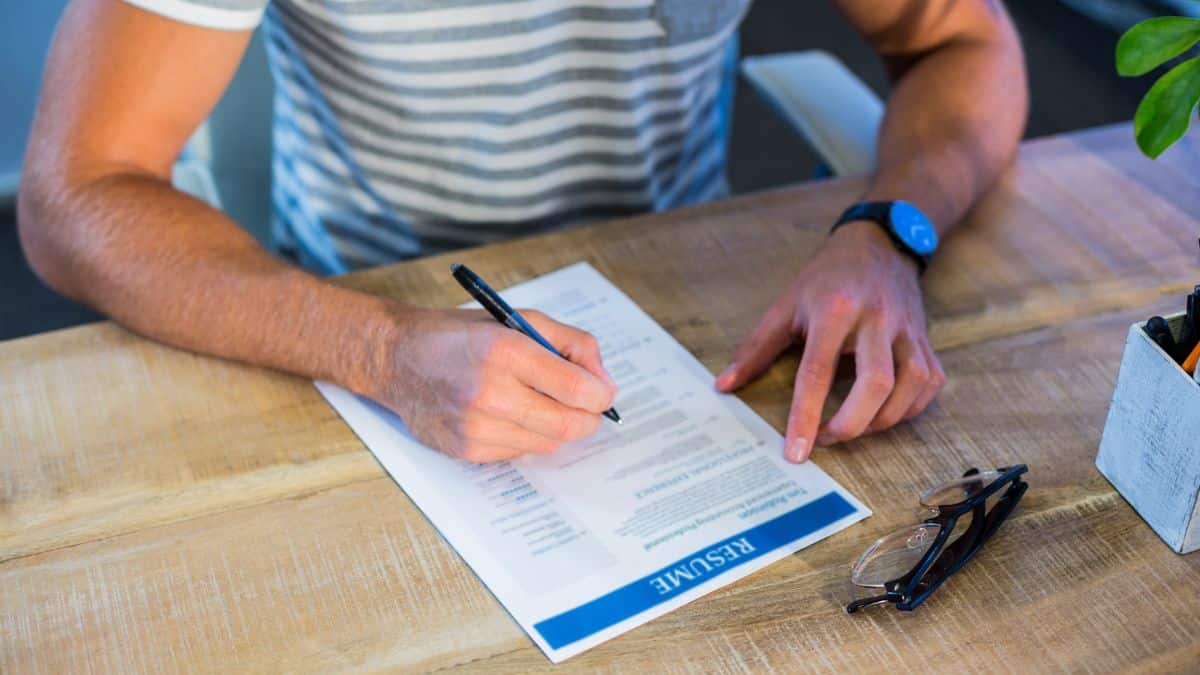
Don’t Repeat Your Resume
Now that you know what you should be doing on your cover letter, let’s talk about some of the things you need to avoid.
Your cover letter is meant to elaborate on your resume, not repeat it. If it doesn’t tell us anything more than your resume already does, why are you even bothering to write one?
Hiring managers don’t want to read the same information twice. They want to see how you can add value to their organization, not just a list of your past accomplishments.
Use your cover letter to talk about your skills and experience in a more natural way. Expand on what you want an employer to know about yourself and your application.

Don’t Be Negative
If you are applying for a new job, you are either unemployed or underemployed, hate your current job , or are worried that you may be about to lose it. None of these situations are fun to be in, but you can’t let that show in your cover letter. You have to keep it positive!
You want to show the employer that you are excited about the opportunity and are confident in your ability to do the job.
If you hate your current job, focus on how you are looking for a new challenge and how you believe this job will be a better fit for you. Or, if you are worried you may lose your job, focus on how you are proactive and are already looking for new opportunities.

Don’t Discuss Why You Need the Job
Everyone knows that you need a job to make money to support yourself and your family. You don’t need to explain this or the details of your specific situation in your cover letter. Mentioning that you are hoping to buy a new house next year doesn’t matter to an employer.
What does matter to an employer is what you can do for them. They want to know how you will:
- make their company more money
- save them money
- make their company more efficient
- help them to avoid potential problems
In your cover letter, focus on what you can do for the employer, not on what they can do for you.

Don’t Make Excuses
Making excuses will only draw more attention to your weaknesses or make you sound like a difficult person to work with.
If you don’t meet 100% of the qualifications they are looking for, that’s okay – just don’t point it out! Let them decide if it’s a deal-breaker or if they are willing to train you in that specific area. They might not even notice!
Avoid making excuses for past job experiences or choices that might negatively reflect on you. If you were fired from a job, for example, simply state that the job wasn’t a good fit and move on. Don’t try to justify your actions or make excuses—this will only make you look bad.

Don’t Lie Or Exaggerate
Many people feel the temptation to lie or exaggerate their skills and experience when applying for a new job. Although lying on your application may seem like a harmless way to make yourself look more qualified, it can lead to serious consequences.
When an employer is interested in hiring you, they will conduct a background check and call your references. If you’re caught lying on your job application, you will likely be immediately disqualified. In some cases, you may even be banned from applying to that company in the future.
Lying on your application can also be a form of fraud, which is a crime in many jurisdictions. Depending on the severity of the lie, you could lose your job, be sued, or even be prosecuted for falsifying documents.
Lying or exaggerating about your experience or education can also lead to problems down the road if you are hired for a position based on false information. For example, if you claim you are proficient at using a specific program that you don’t really know much about, you will struggle in your new role. Not being able to do your job will be stressful and raise questions with your employer. Unless you’re a quick learner, you will probably find yourself job searching again within a few months.
So, the next time you’re tempted to fudge the truth on your application, remember the potential consequences. Be honest on your applications, and you’ll be much better off in the long run.

Don’t Send a Generic Letter
As mentioned, your cover letter should be unique to each employer and job opportunity. Don’t simply copy and paste the same letter for every job application. A few small tweaks are all you need to make your cover letter specific to each job and increase your chances of getting an interview.
If it’s obvious that you’ve created one cover letter and are using it repeatedly to apply to dozens of jobs, it gives the impression that you don’t really care if you get this job or not – you just want any job. And while that may be true, you don’t want to create any apprehension with an employer.

Don’t Use Clichés or Slang Terms
Avoid using clichés, slang, and overly casual language when writing a cover letter. Such language can come across as unprofessional and may not convey the message you are trying to get across in the best way possible.
Clichés include phrases like “I’m a people person” or “I’m a go-getter.” These phrases are overused and do not add anything unique to your letter.
Using slang can give the impression that you are not taking the process seriously. It can also make it difficult for the reader to understand what you are trying to say. Instead, focus on using clear and concise language, which will get your point across in a way that is both professional and respectful.
While it is important to be friendly and personable in your letter, being too casual can make you seem unprofessional and could hurt your chances of getting the job.

Don’t Include Unnecessary Personal Information
There are a few reasons why you should not include personal information in your cover letter. First, it is not necessary. The employer is only interested in your qualifications and not your personal life.
Second, while it may seem like a good idea to make yourself seem more relatable, including personal information can actually have the opposite effect. It can make you appear unprofessional.
Third, including personal information on your cover letter can be a privacy concern. If an employer knows too much about your personal life, they could potentially use this information against you. For example, if you mention that you have young children, the employer may assume that you will need to take time off for childcare. As a result, you may be passed over in favor of a candidate without the same responsibilities.
Lastly, sharing personal information in your cover letter could also lead to identity theft. If you include your home address or phone number, a savvy thief could use this information to steal your identity. By including personal information in your cover letter, you could be putting yourself at risk.
Overall, you should always err on the side of caution to protect your privacy. Stick to the facts and let your qualifications speak for themselves.

Cover Letters Are Tricky But Beneficial
It can be difficult to strike the right tone in a cover letter. You want to sound enthusiastic and professional without coming across as desperate or pushy. The goal is to show that you’re a good fit for the company, so focus on that.
If you’re not sure how to get started, plenty of cover letter examples are available online. Just make sure to tailor the letter to the specific company and position you’re applying for, and only include the skills and experience that you actually have.
With these tips, you should have no problem creating a cover letter that will stand out and help you get hired.

Quick Resume Tips
If you want to make a good impression and stand out from the competition, here are 20 resume do’s and don’ts . Following these simple tips, you can be sure that your resume will make a great impression on employers.

Add Your Side Hustle to Your Resume
Job seekers are told they need to stand out if they want to get hired. But how? One of the easiest ways is to include their side hustle on their resumes . Your side hustle is teaching valuable job skills that can make you a stronger candidate. Not mentioning this on your resume or cover letter is a mistake!
More for You
Miss Teen USA resigns two days after Miss USA: ‘My personal values no longer fully align’
Mavericks coach says players don't want to play with Luka Doncic
Housing has hit rock bottom, says Redfin CEO Glenn Kelman
I quadrupled my salary to nearly $200,000 by age 30 because I advocated for myself and knew when to pivot. Here's how I did it.
Justin and Hailey Bieber Expecting First Child
13 Cities That You Can’t Believe Are Retirement Paradises
The signature breakfast dish from your state
22 Movies So Intense We Never Want to Watch Them Again
'The worst investment people can make': Real estate guru Grant Cardone says too many Americans are chasing after the dream of homeownership. Here's what he thinks you should do instead
Which team has the toughest 2024 schedule in the NFL?
The best jobs for introverts, according to new research—some pay over $100,000
5 years ago renters needed to make less than $60,000 a year to afford the typical rent; now they need to make almost $80,000
20 Best Sandwiches in America You Need to Try At Least Once
Here's How Long The Automatic Transmission In Your Car Will Probably Last
Popular KTLA entertainment reporter Sam Rubin dies aged 64
‘Worst’ Netflix film of 2024 tops chart with 7 million views in three days
An AI Photo of Katy Perry at the Met Went Viral and Fooled Everyone
The 12 Best Remote Entry-Level Jobs That Will Pay You $50,000 or More
Here is the true value of having a fully paid-off home in America — especially when you're heading into retirement
5 Things You Need To Stop Doing If Your Car Has An Automatic Transmission
- Hiring Advice
- Career Advice
- Hiring Platform
- Interview advice
- HR Insights
- Product Innovations
- Fresher advice
- Resume tips
- Hiring Guidelines
- City wise jobs

Securing a job in today’s competitive job market is pretty challenging, a well-written job application letter can make all the difference in landing a dream job. It serves as your first introduction to your potential employer and offers a valuable opportunity to showcase your qualifications, skills, enthusiasm, and suitability for the role.
To explore the ins and outs of writing a job application letter, and how to make a strong impression with it, check out this blog. This blog will show you how to write an exceptional job application letter that will help you stand out from the competition.
A job application letter is commonly referred to as a cover letter. This letter of application is a document that is sent along with your resume when you apply for a job. Its main purpose is to introduce yourself to the potential employer or hiring manager, providing an opportunity to present your skills, qualifications, and experience that are relevant to the job you’re applying for. Additionally, it aims to persuade the hiring manager to consider you for the role.
Therefore, a strong job application letter serves as your ultimate gateway to your dream job.
- Components of a Job Application Letter
To draft an outstanding application you need to follow the right step to write a letter. Therefore, here are the key components that you should follow:
Include your contact information and the date at the top of the letter, followed by the employer’s contact details.
Begin your letter with a formal greeting to the hiring manager. It’s best to address the letter with the name of the hiring manager. For this, it’s advisable to call the company and ask for the hiring manager’s name as it would look professional. Alternatively, use a generic salutation like “Dear Hiring Manager”.
Craft a standout introduction to build that positive impression from the start of your letter. Your introduction should highlight your relevant skills, experiences, and achievements that make you a suitable candidate for the job.
Highlight what value you can bring to the company with this position. Talk about why you’re the perfect fit for the job; this way, you can showcase your professional skills and stand out from other applicants.
Express your enthusiasm for the position and reiterate your interest in the opportunity. Also, thank the employer for considering your application. End the letter with professional closing for example: “Yours sincerely”, “Best regards”, or “Thanks for your consideration”, followed by your name and signature.
Read More: All You Need to Know About Resume Headlines – With Example
- Tips on How to Write a Job Application Letter

Customize your application letter for the job; formally, it’s best to follow the key components that we discussed above. This way, you can tailor your application letter to each job, highlighting the qualifications and experiences most relevant to the position.
Show your understanding of the company and its values in your application letter as this shows that you are aware of what the company does, and your genuine interest in the position.
Though you have a lot to say and express in your letter, do not go over the board, keep it concise and to the point, focusing on key skills and experiences that align with the role.
It sometimes happens that the hiring manager may not read the entire letter but rather would just find the relevant keywords that match the job requirements. Additionally, incorporating keywords will also help your application stand out to applicant tracking systems (ATS).
Finally, once you have drafted your outstanding job application letter, give a quick check on the grammatical errors to ensure the letter is professionally well formatted without any blunders.
- Best Job Application Letter Format (Example Templates)
Subject: Application for the Role of [Job Title] at [Company Name]
I am writing to express my interest in the [Job Title] position listed on [where you found the job posting]. As a recent graduate from [University/College Name], I am excited about the opportunity to contribute to [Company Name] and grow both personally and professionally.
During my academic studies, I developed strong skills in [relevant skills or coursework]. I am particularly drawn to [specific aspect of the company or job description] and am eager to apply my knowledge and enthusiasm to support [Company Name]’s goals.
I am highly motivated and detail-oriented, and I possess excellent communication skills. I am confident that my academic background and passion for [industry or field] make me a strong candidate for this position.
Thank you for considering my application. I look forward to the opportunity to discuss how my skills and experiences align with the needs of [Company Name].
Best regards,
[Your Name]
Subject: Job Application for [Job Title] Position at [Company Name]
Dear [Hiring Manager’s Name],
I am writing to apply for the [Job Title] position at [Company Name], as listed on [where you found the job posting]. With over [number of years] years of experience in [relevant industry or field], I am excited about the opportunity to bring my expertise to your esteemed organization.
In my current role at [Current Company], I have successfully [mention key achievements or responsibilities]. These experiences have equipped me with strong skills in [relevant skills or competencies], including [specific skills mentioned in the job description].
I am particularly drawn to [specific aspect of the company or job description], and I am confident that my background in [relevant experience or industry] aligns well with the needs of [Company Name].
Thank you for considering my application. I am eager to further discuss how my qualifications and experiences can contribute to the continued success of [Company Name].
Yours Sincerely,
Subject: Expressing Interest in [Job Title] Position at [Company Name]
I am writing to express my interest in the [Job Title] position at [Company Name], as posted on [where you found the job posting]. With [number of years] years of experience in [relevant industry or field], I am confident in my ability to contribute effectively to your team.
In my previous role at [Previous Company], I [briefly mention key responsibilities or achievements]. These experiences have honed my skills in [relevant skills or competencies], and I am eager to apply them to drive success at [Company Name].
I am particularly impressed by [specific aspect of the company or job description], and I am excited about the opportunity to collaborate with the talented team at [Company Name].
Thank you for considering my application. I look forward to the possibility of discussing how my background and expertise align with the needs of your organization.
Read More: Resume Headline For Freshers: 30+ Examples and Tips
Now that you’ve reached the end of this article, you understand that a well-written job application letter can significantly enhance your chances of securing an interview with your dream company in this challenging job market. Therefore, follow these tips, key components, and templates to draft a successful job application letter that impresses your hiring manager. With the right approach, you’ll be one step closer to your next career opportunity.
Apna is the top job networking platform in India. With easy-to-use features, you can connect with potential employers, build professional networks, find job opportunities , and gain access to resources for career growth. Get the Apna App now and take charge of your career!
- Job Seekers
- tips and tricks
Looking for a new opportunity?
Get access to over 5000 new job openings everyday across India.
Related articles
Top 20 group discussion topics for mba placements: a complete guide, what is probation period and tips to pass it successfully, remote work revolution: how it shapes career and skill development.
Follow us on social media

IMAGES
VIDEO
COMMENTS
1. Follow company instructions. Email cover letters can generally be sent in one of two ways: as an email attachment or as the body of your email. Before sending your cover letter, check the company's job application guidelines. Some companies prefer attachments, while others prefer them to be in the body of your email message.
Choose a file name and select either 'Word Document (.docx)' or 'PDF' under File Format. Click Save. In Google Docs: Open your CV. Go to File → Download…. Select 'Microsoft Word (docx)' or 'PDF document (.pdf)' under File Format. Check your Downloads folder or click the document at the bottom of your web browser to open it.
The email must contain your cover letter, either in the body of the email or as an attachment, and your CV as a separate attachment. Do you need to send your CV and cover letter via Email? With the massive technological boom over the past decade, we have seen the dramatic rise in email applications.
You'll also need to ensure that you have a clear introduction, main body, and closing paragraph so that hiring managers can skim for and find the information they're looking for. 2. Be direct and to the point. When writing an email cover letter, the trick is to make it informative but short.
For example: "I am applying for the role of [precise job title], as advertised on [company website/recruitment website]". "I would like to put forward my application for the role of [job title] as advertised on [company website/recruitment website]. Job reference number: [XXXXX].".
Click on your cover letter to attach it to the email. Check that the file attaches correctly before sending. 6. Write a short email message. If you are sending your cover letter as an attachment in an email, include a brief email message to let the recipient know that the email contains your cover letter as an attachment.
To write a perfect cover letter email for a job application, follow these steps: Use our email cover letter template. Apply a clear, strong subject line. Open with a proper greeting—address the hiring manager by their name. In the first sentence, explain why you're writing and what position you're targeting.
8. Always send a test message first. Before you click "Send," send a test message to yourself to be sure the email message is perfect and that all your attachments come through. You may also wish to send a copy of the message to yourself for your records by adding yourself as a BCC (blind carbon copy) recipient.
3. Make your subject line clear and professional. The subject line of your email should be brief and to the point. There are three elements to a professional email subject line: Your name. Target job title. The term "job application". Here's an example of a good subject line for emailing a resume:
How to send a resume email. When you email your resume and cover letter, you're pitching yourself for the job. Here are some tips to keep in mind when preparing an email to a recruiter or hiring manager: Use a professional email address. Avoid sending your resume using an email you created when you were 15.
Examples of introduction when emailing a resume: "My name is Roger Jones. I'm writing this email to express my interest in the job vacancy at Valcor". "My name is Roger Jones, and I am submitting my application for the current job opening as Financial Analyst at Valcor.". "My name is Roger Jones. I came across Valcor's job ads on ...
Best email template for sending resume. You've read our 8 sample resume samples, but we've saved the ultimate email for last. Here's the best email template for sending a resume by email. Hi (Recipient's name), I have attached my resume for the position of (insert details).
Add a clear subject line. Make the point of your email clear with a logical subject line - you could include the job title of the vacancy you're applying for, for example, or refer to the fact that the email is a job application or resume. Choose a professional greeting. Think "Dear [name]," or even just " [name]," rather than "Hiya ...
Add the job title to the subject line and first line of your email. Use the 3-paragraph cover letter format, but keep it short and snappy. Find resume keywords in the job ad. Include one big achievement relevant to the job. Expert Hint: Don't forget to attach your resume to the cover letter in your email!
Here are a few examples: Your name - Application for (job name) - Reference. Application for (job name) - (your name) - Reference. Applying for a job probably is the best place to get creative, so stick to a simple subject line for your job application emails. 2.
Once your email message is ready to send, you need to attach your resume and cover letter to your message: Click on Insert > Attach File. Your email client will display a list of files in the default file folder of your computer. If your resume and cover letter are stored in a different folder, click on the appropriate folder.
Like your resume, your cover letter is your chance to brag (professionally) about why they should hire you. Be proud of your skills and accomplishments, and use them to explain why you are the ...
A job application letter is commonly referred to as a cover letter. This letter of application is a document that is sent along with your resume when you apply for a job. Its main purpose is to introduce yourself to the potential employer or hiring manager, providing an opportunity to present your skills, qualifications, and experience that are ...